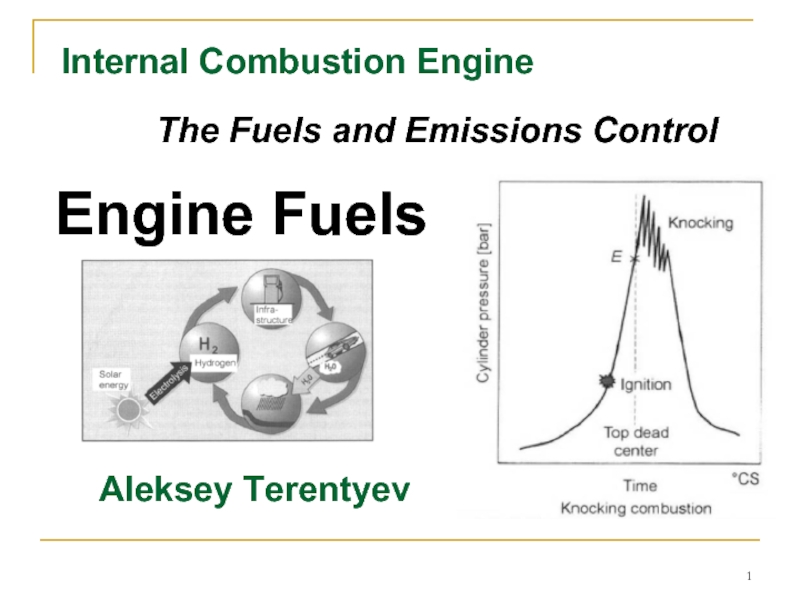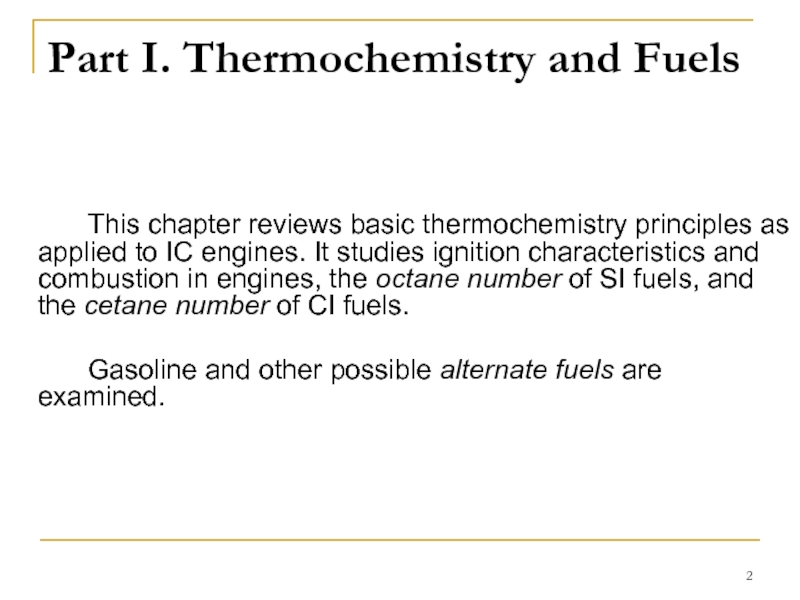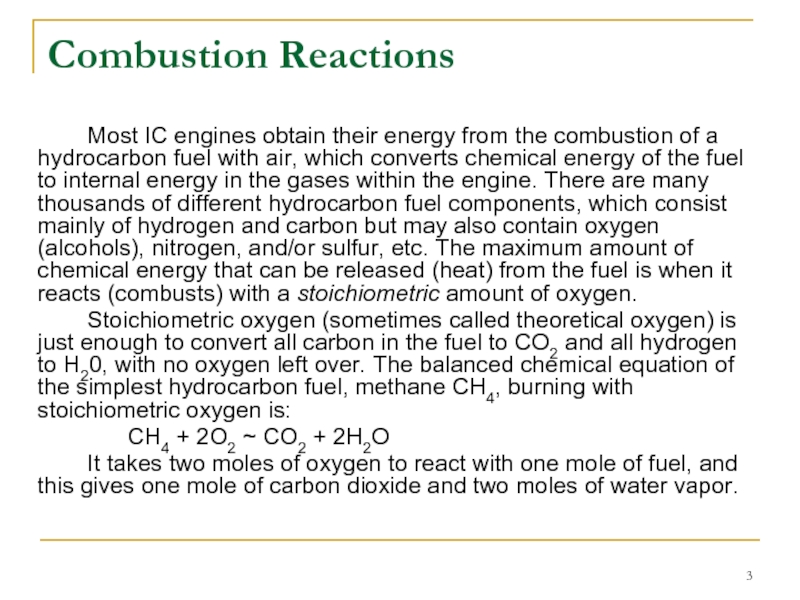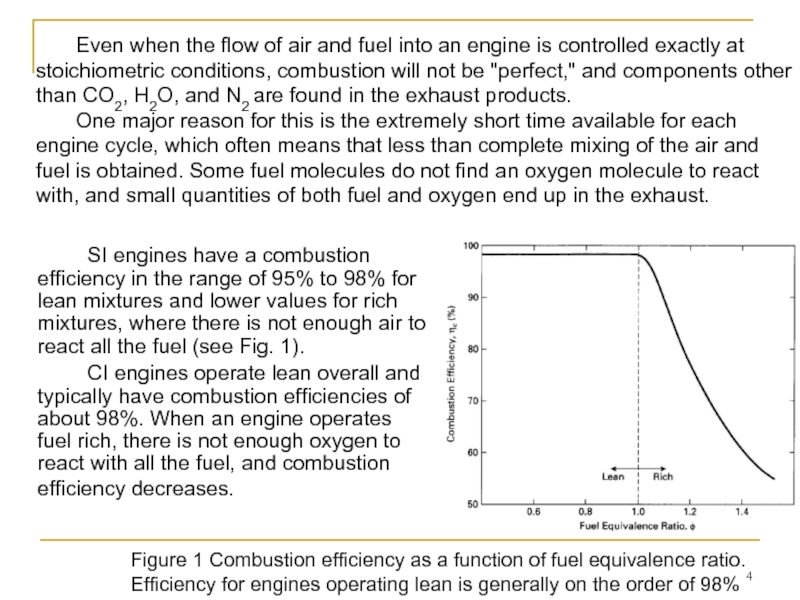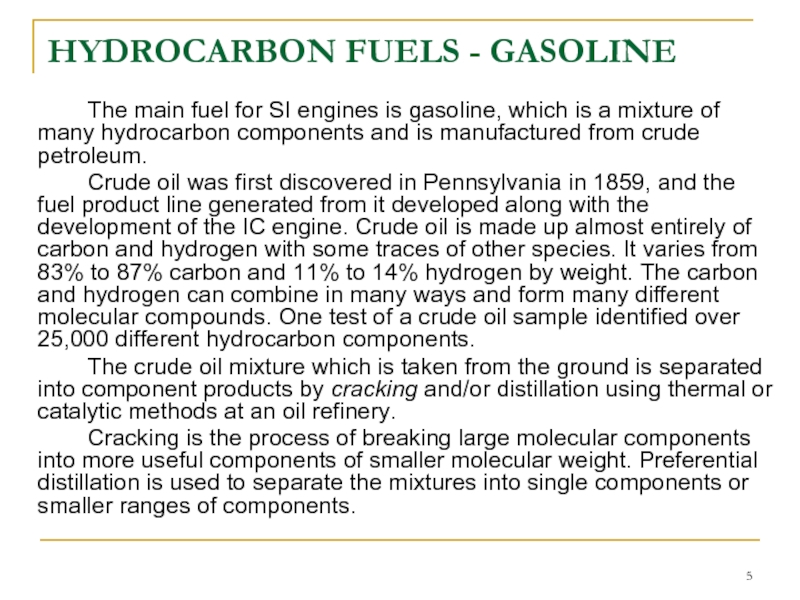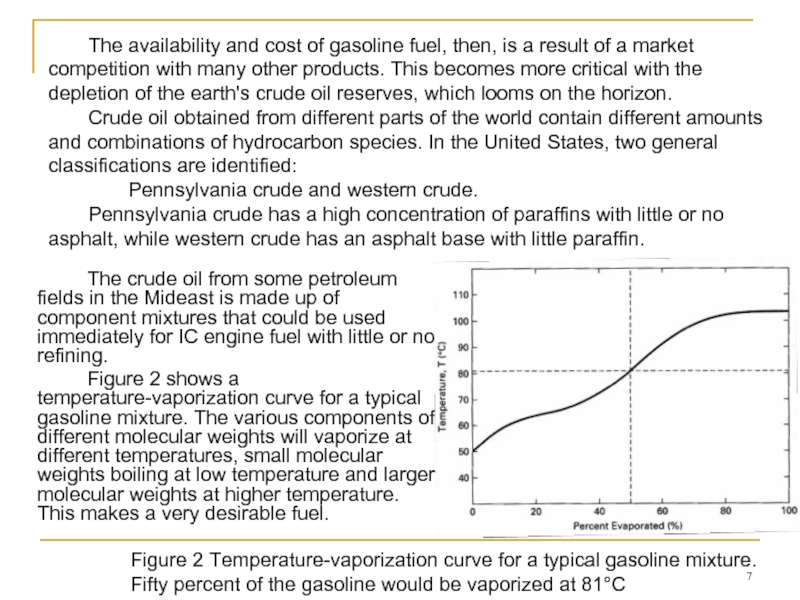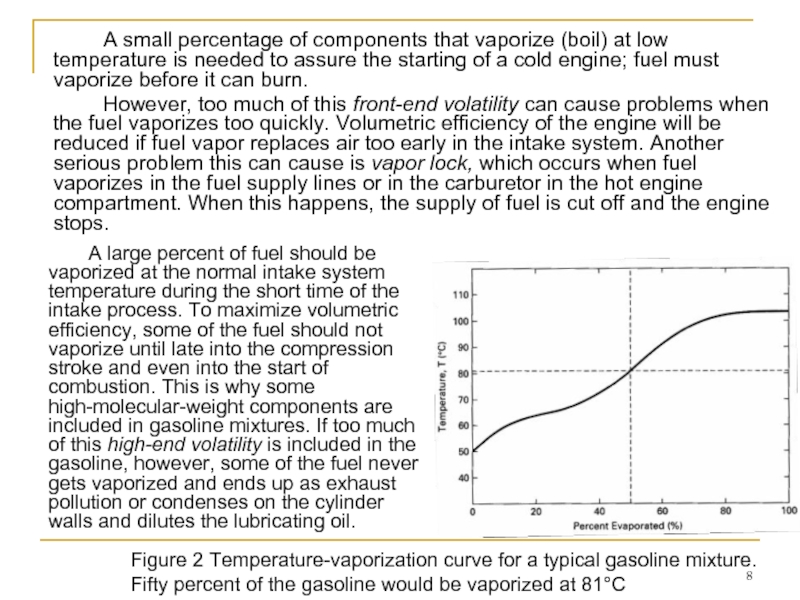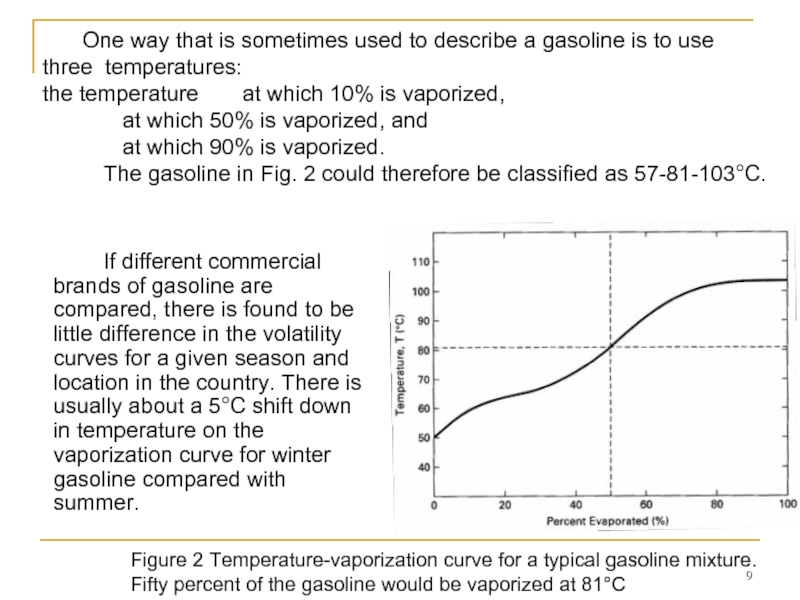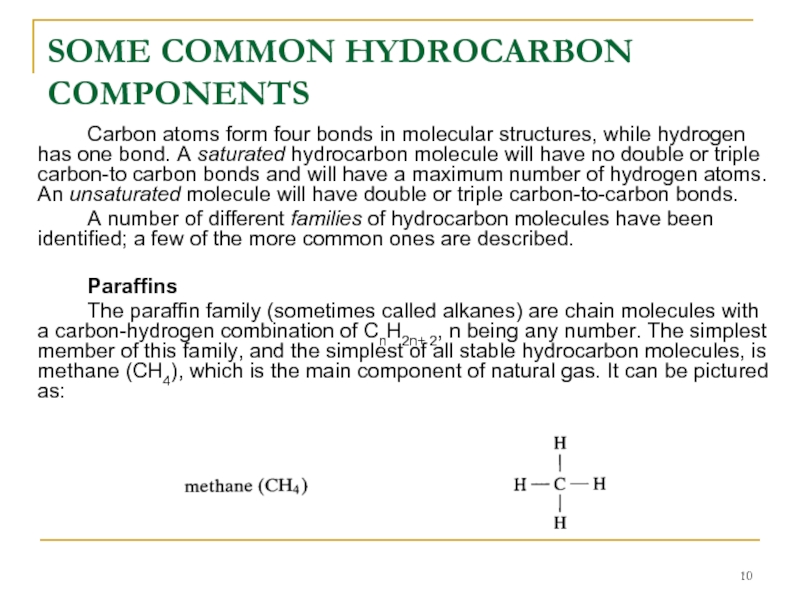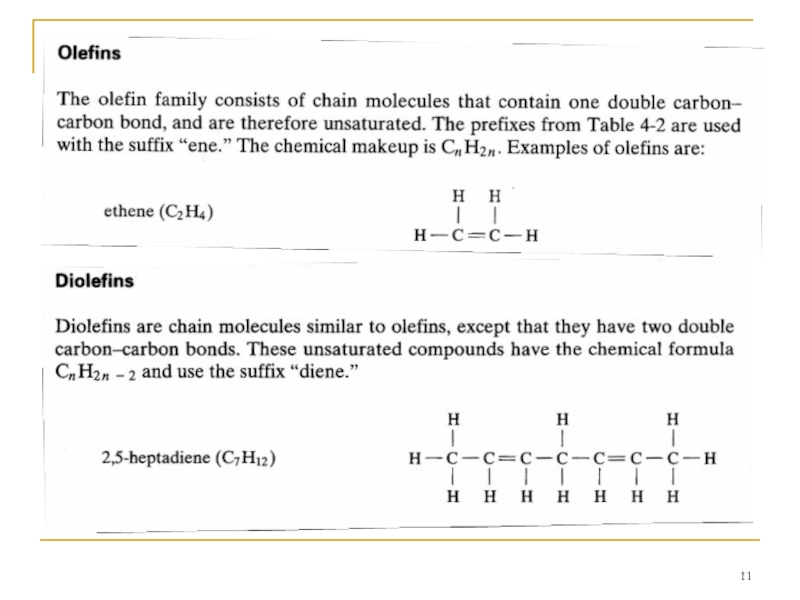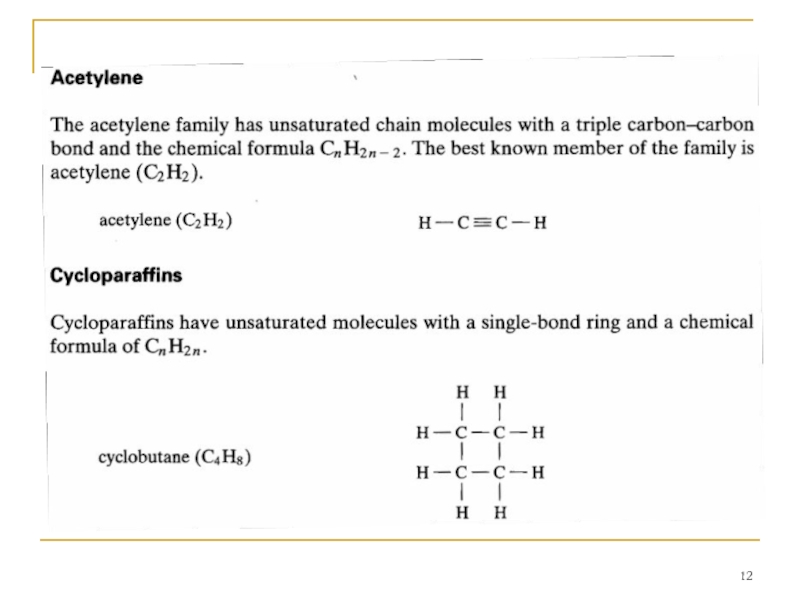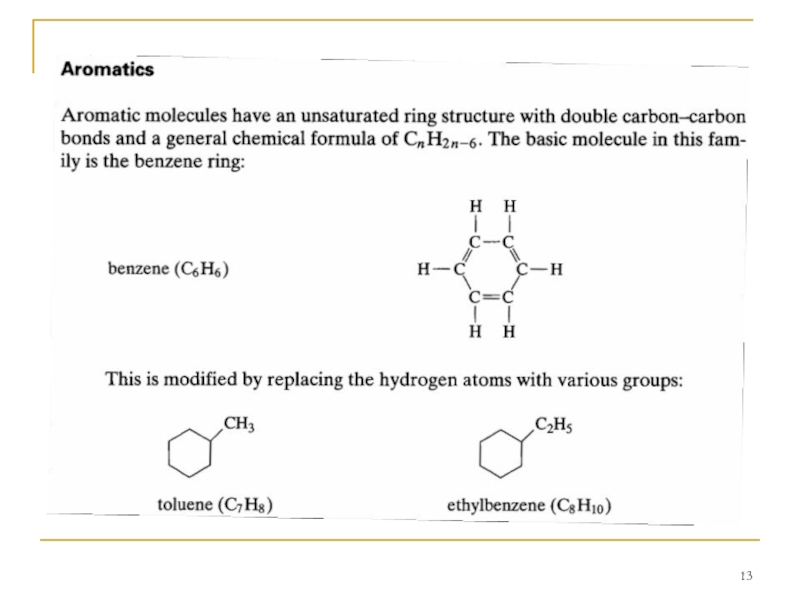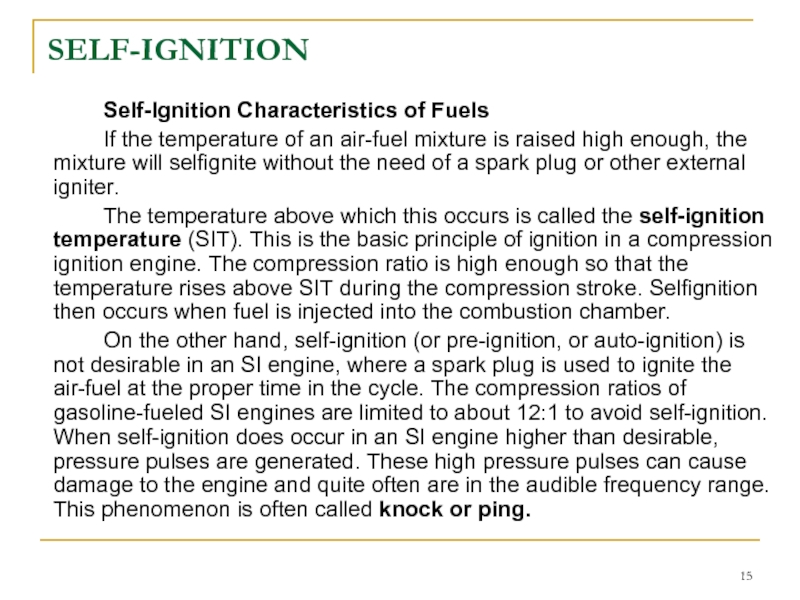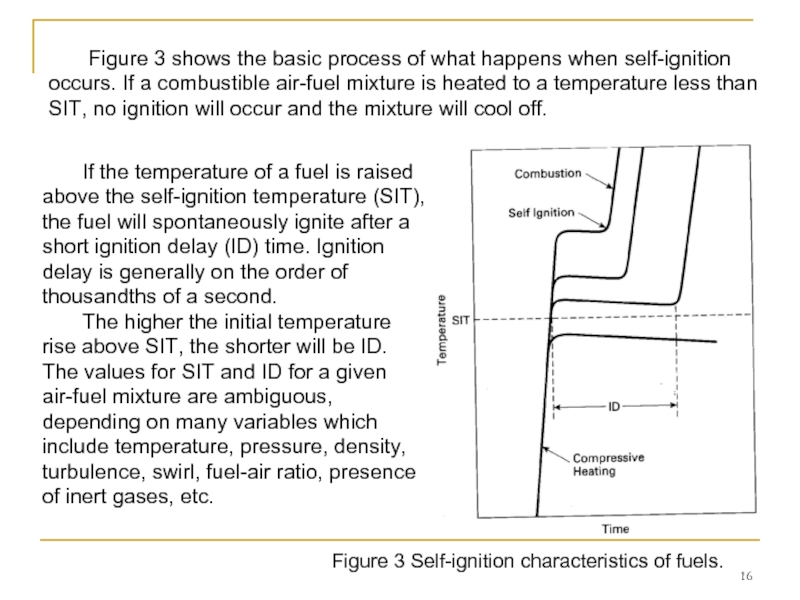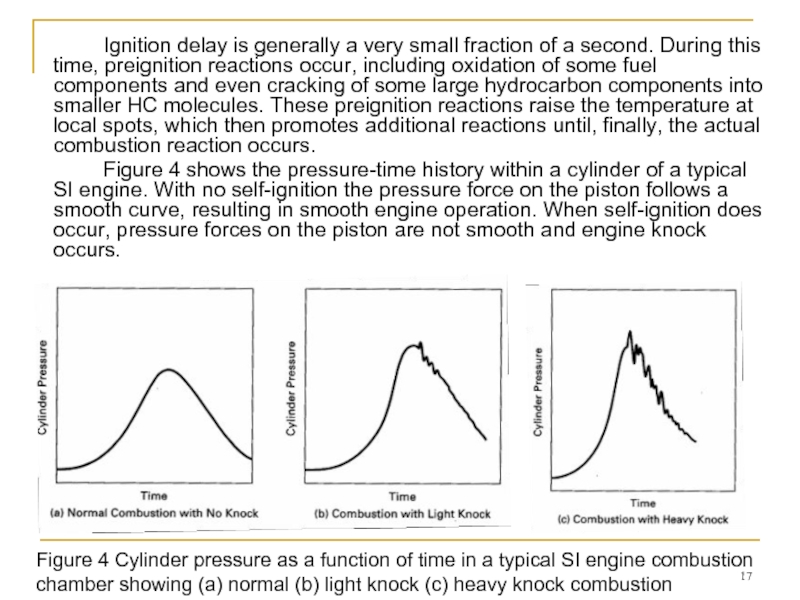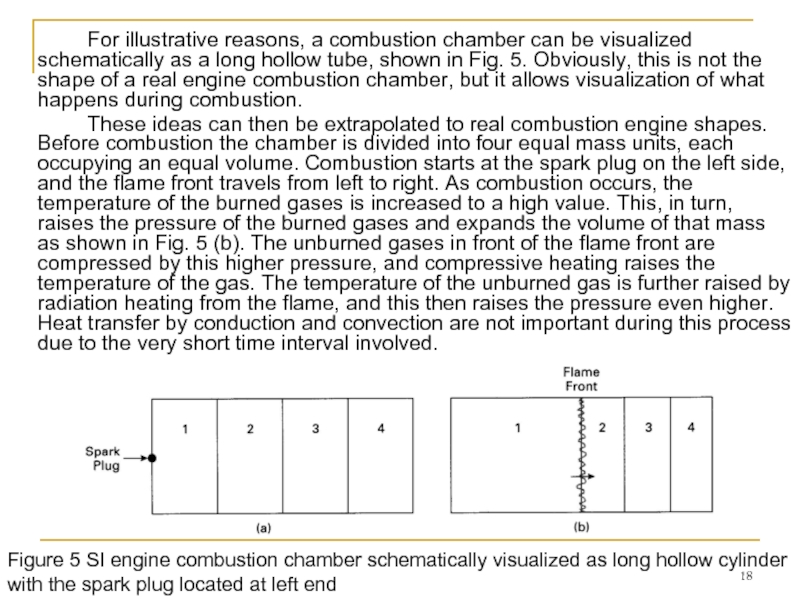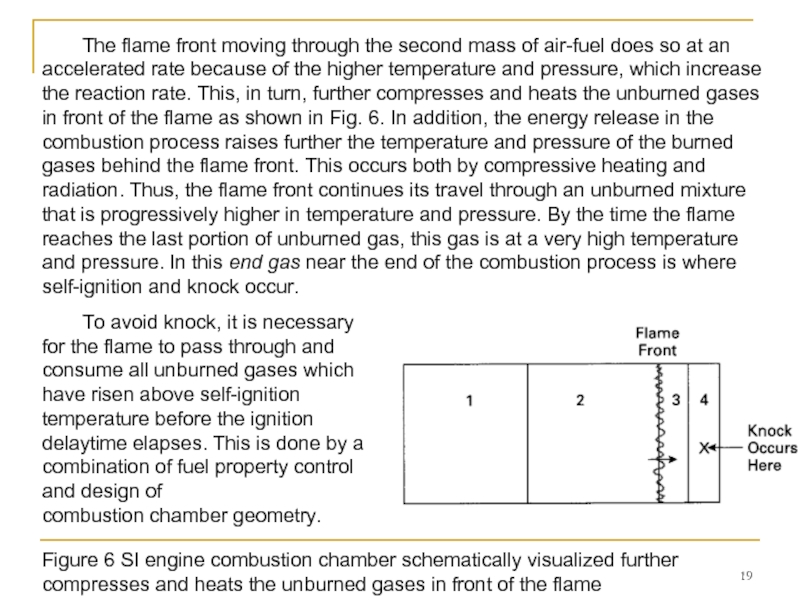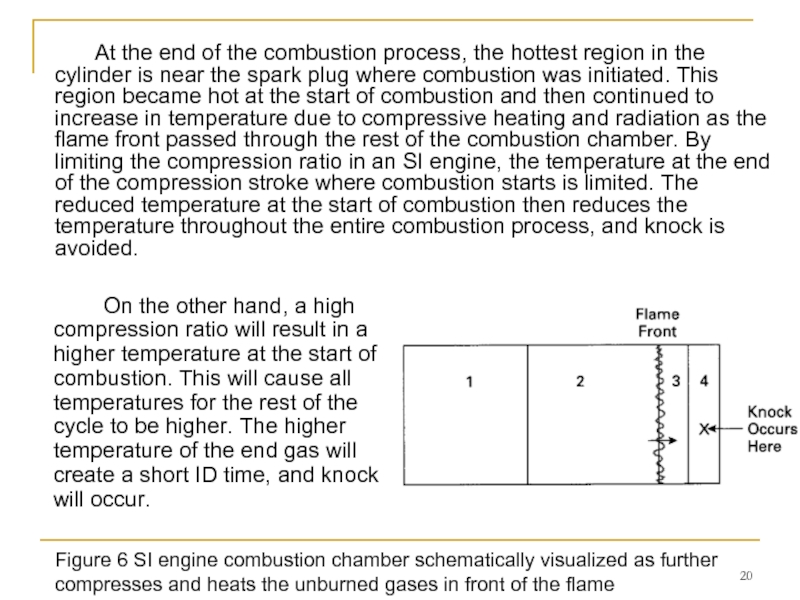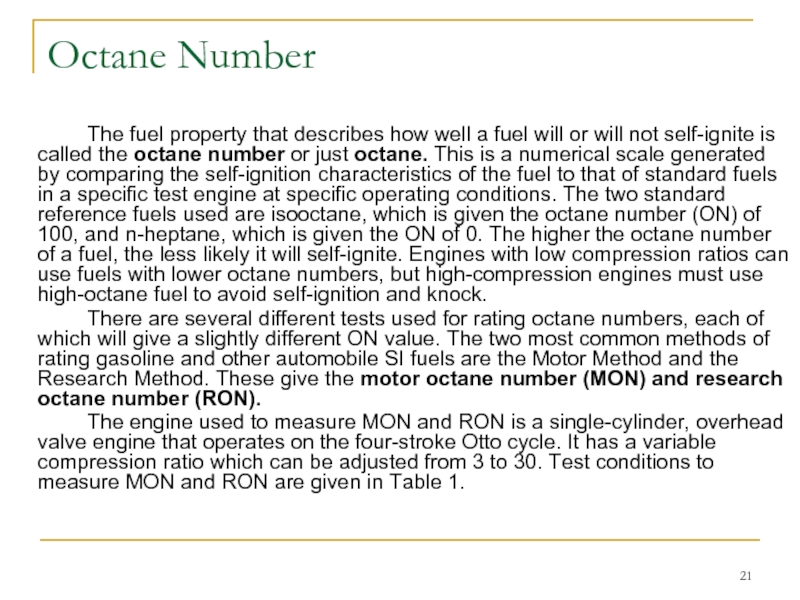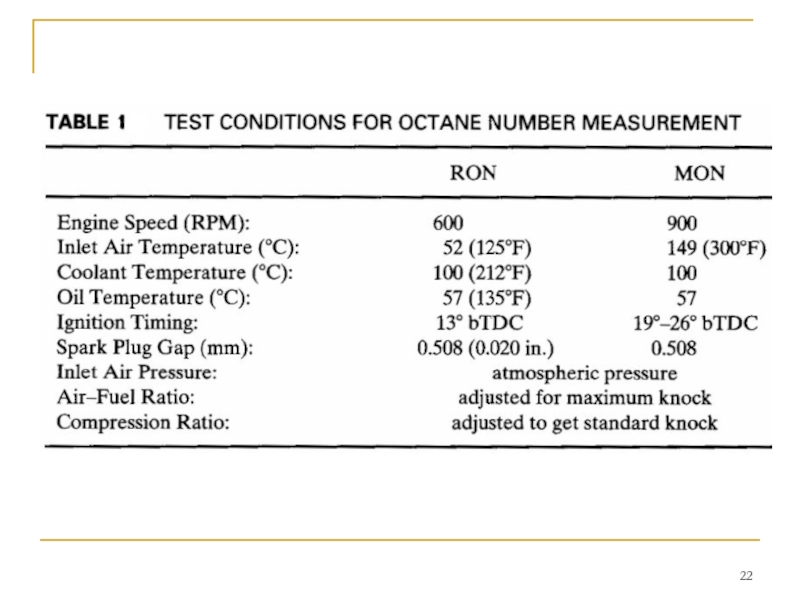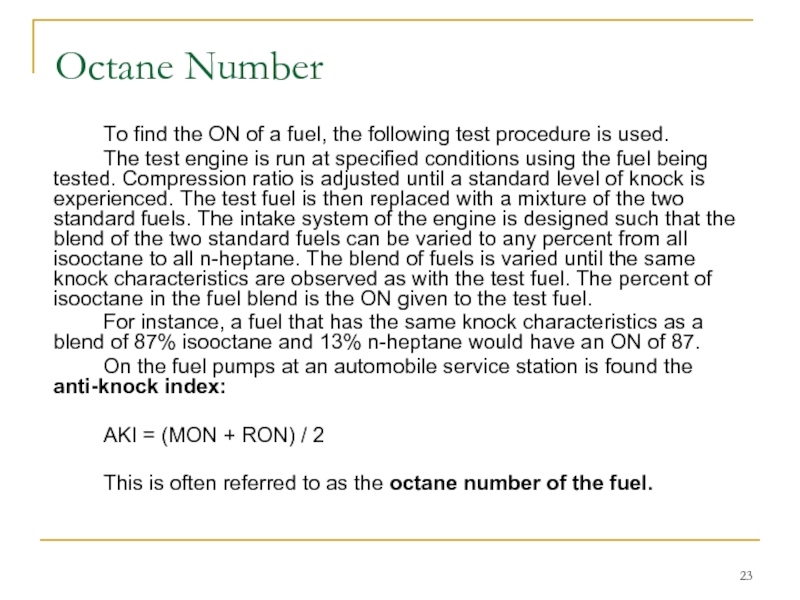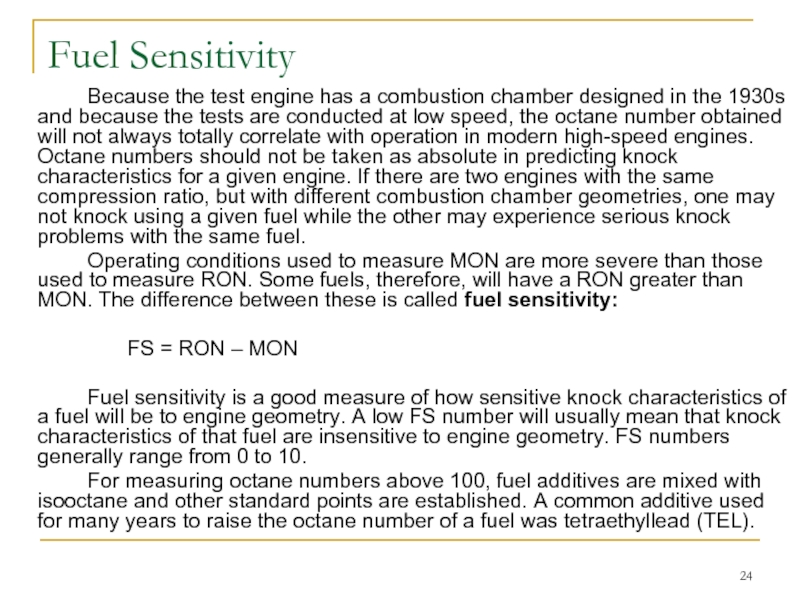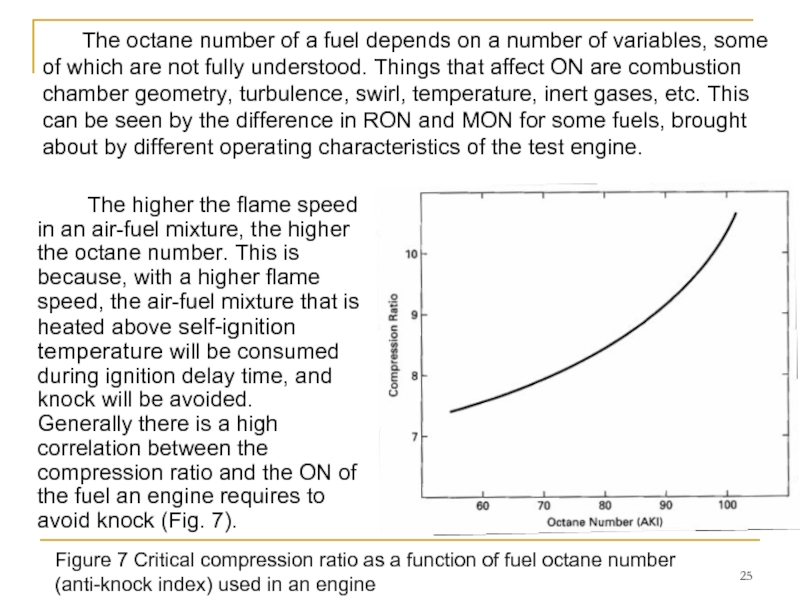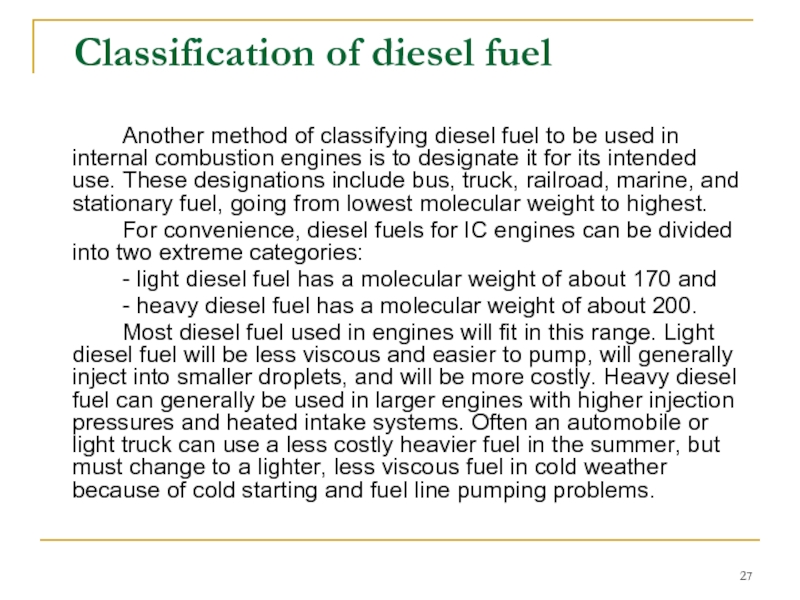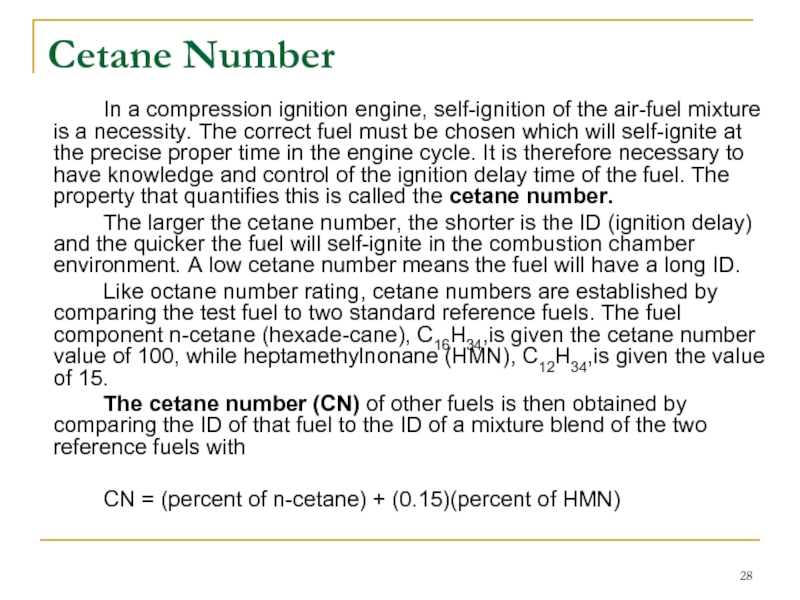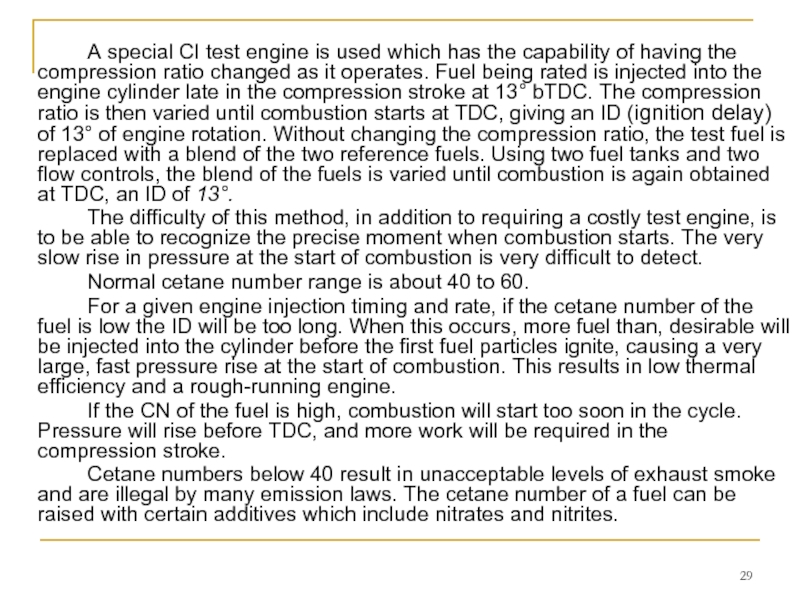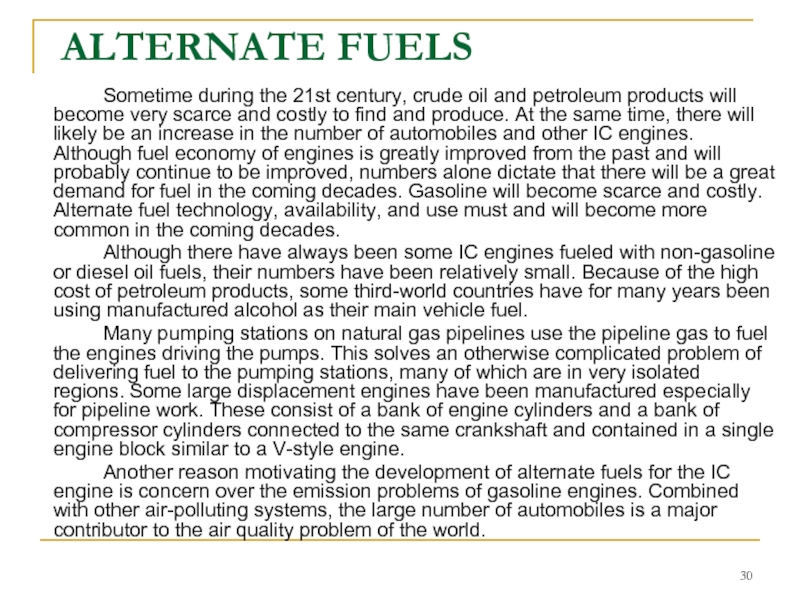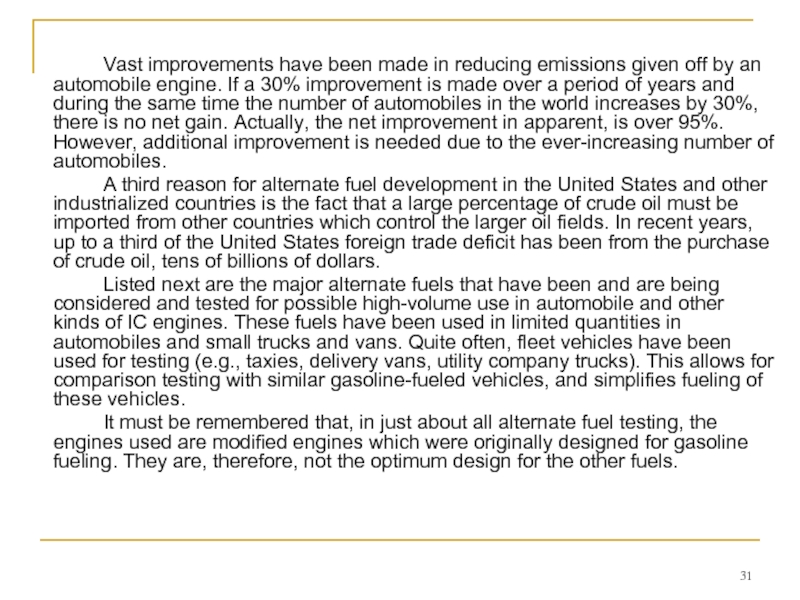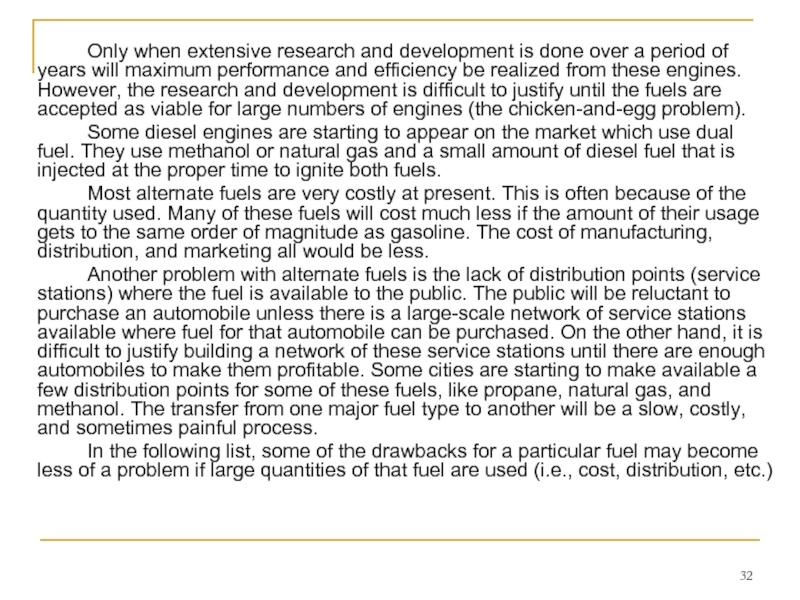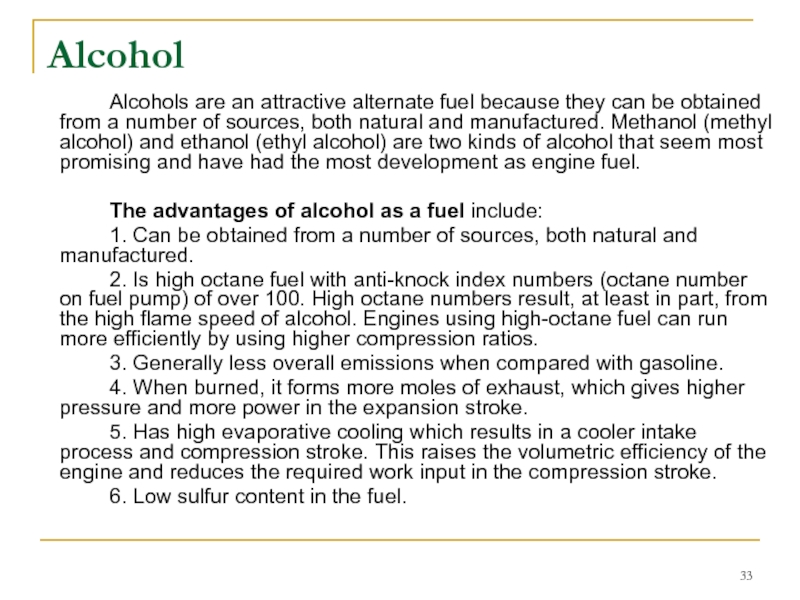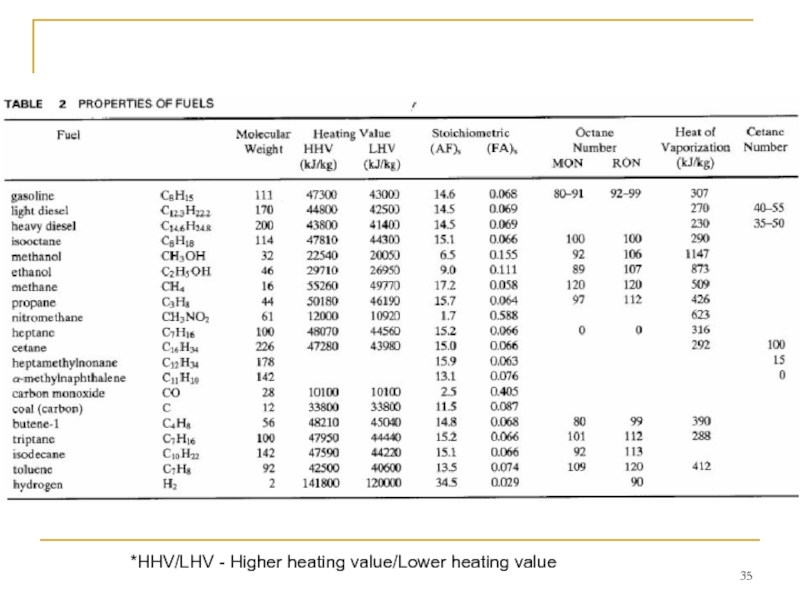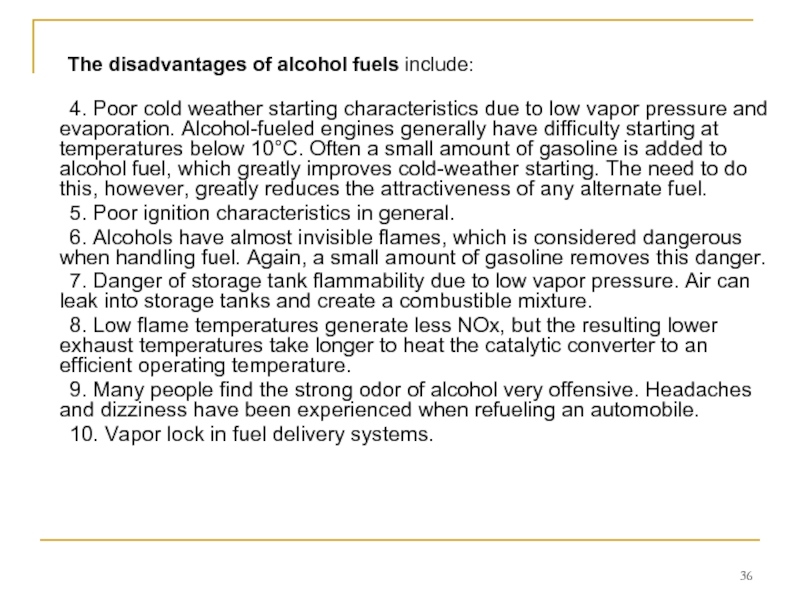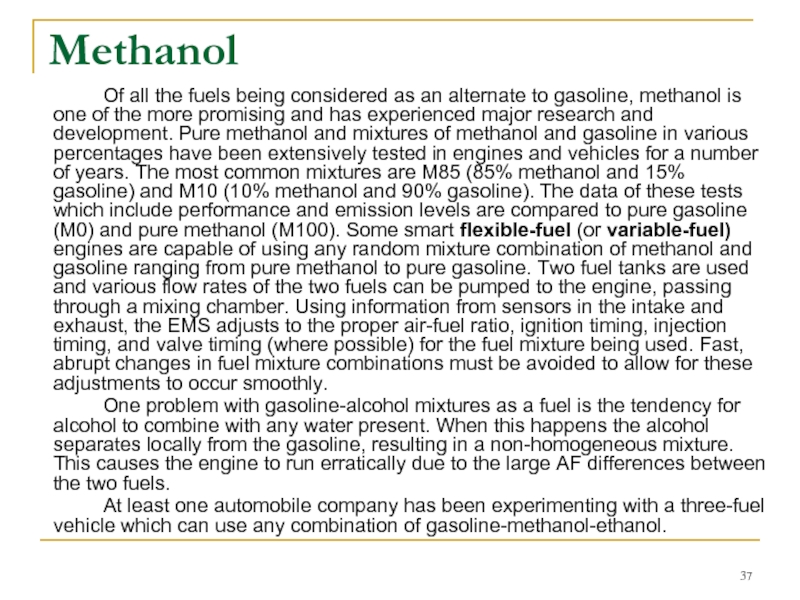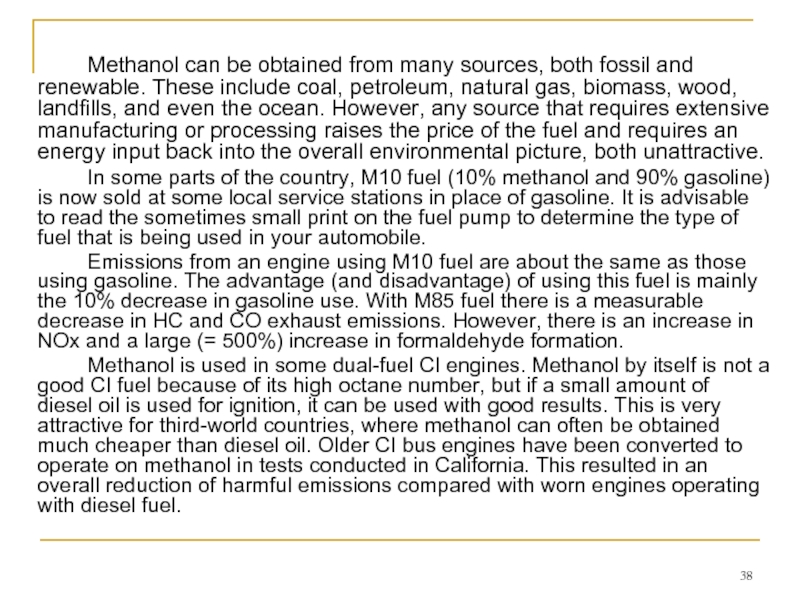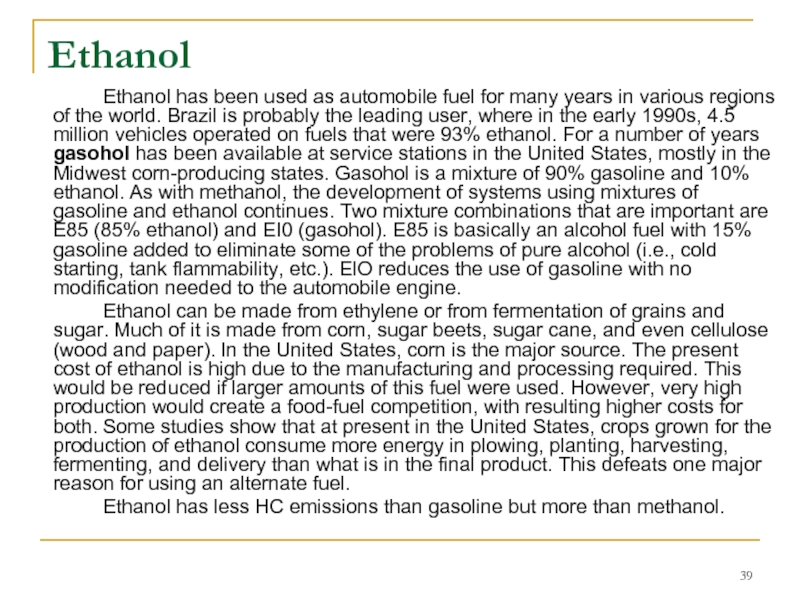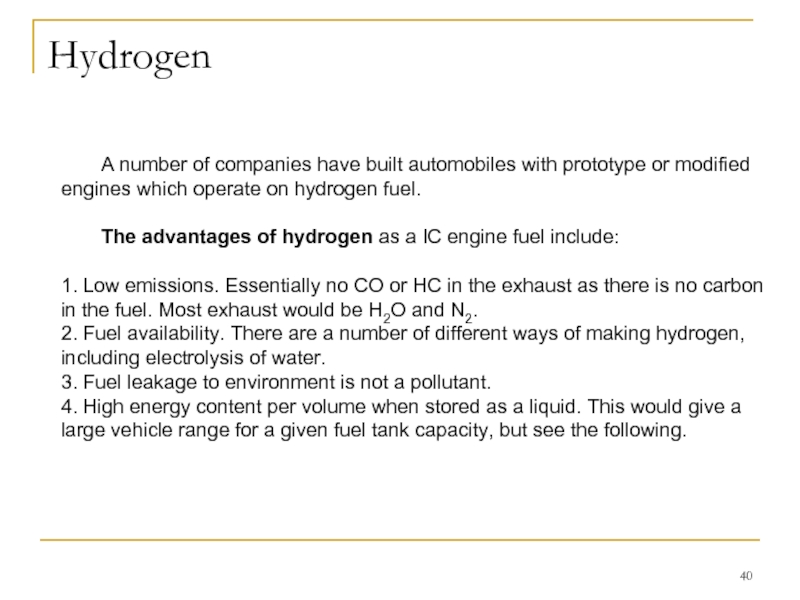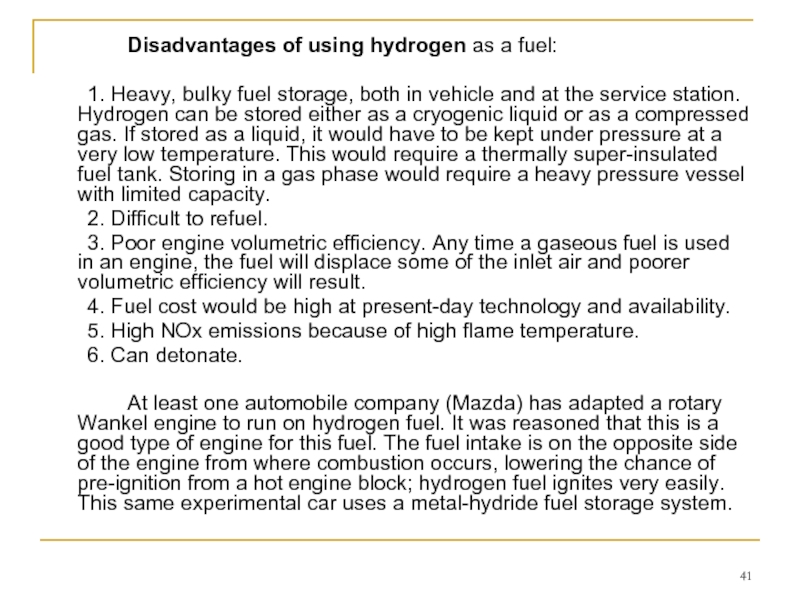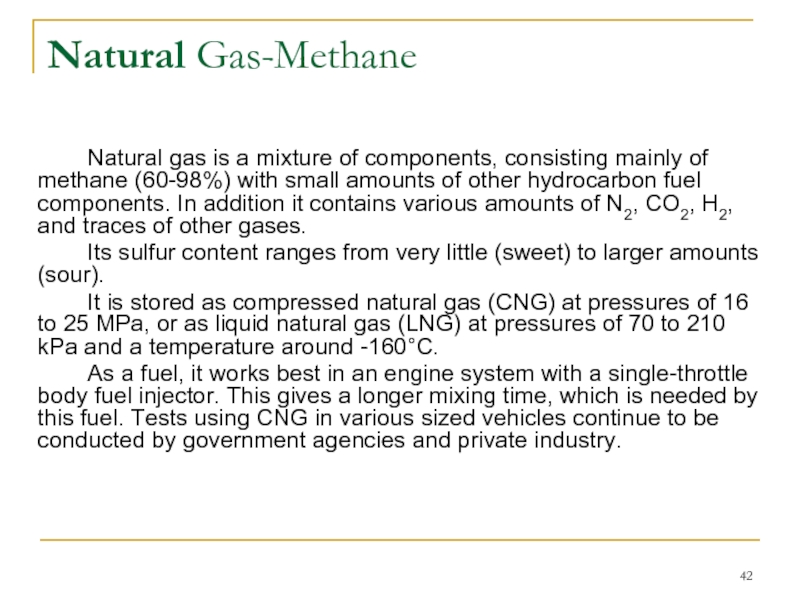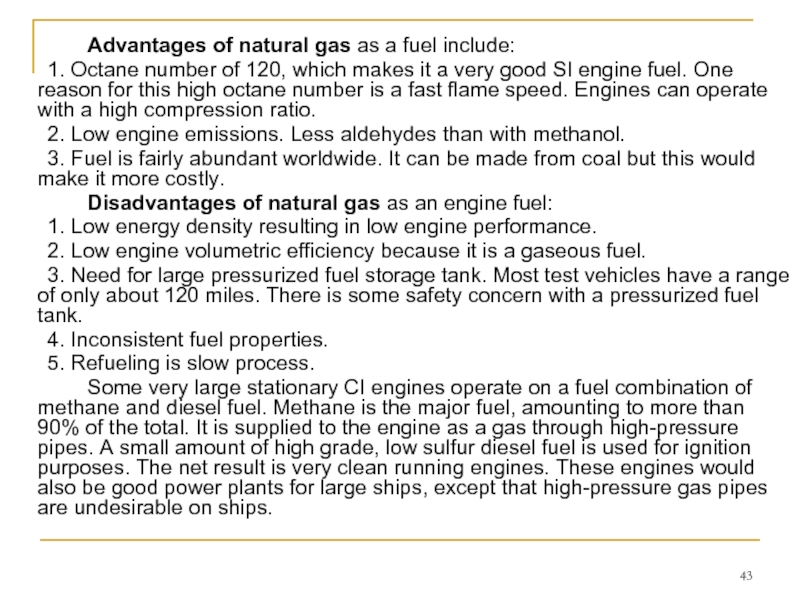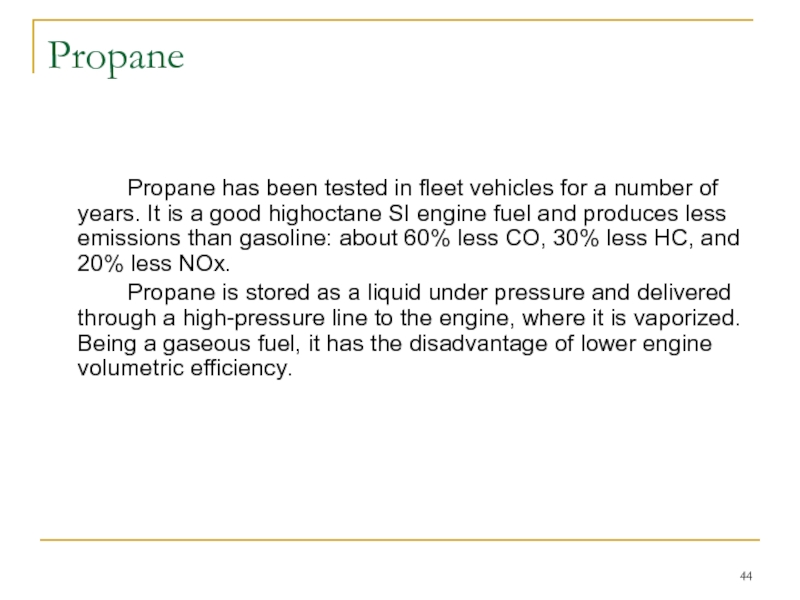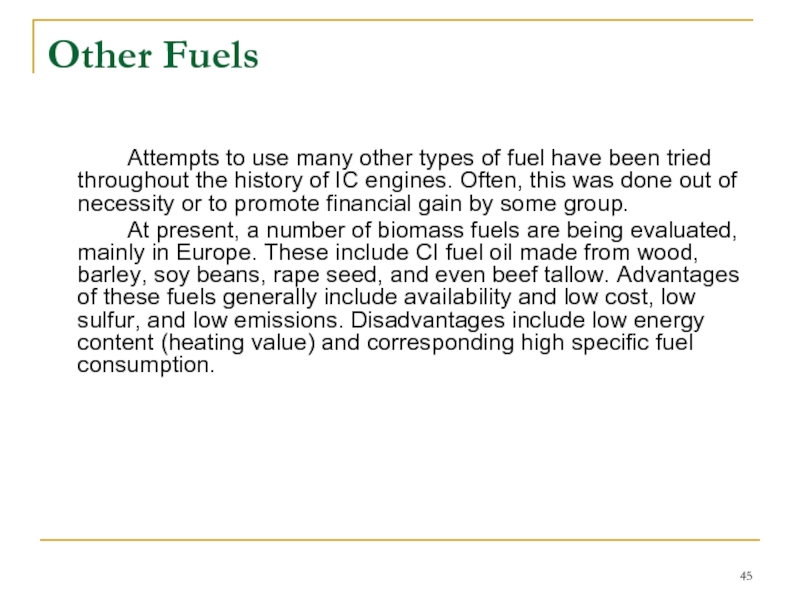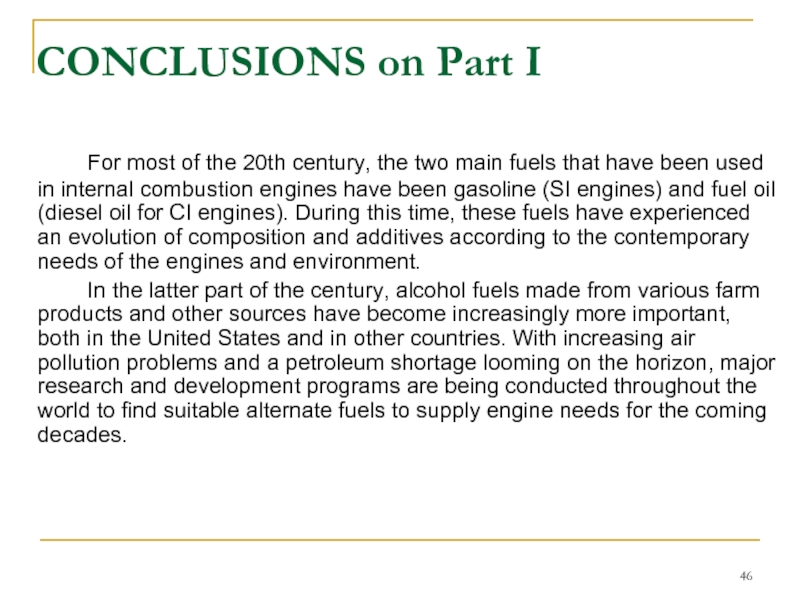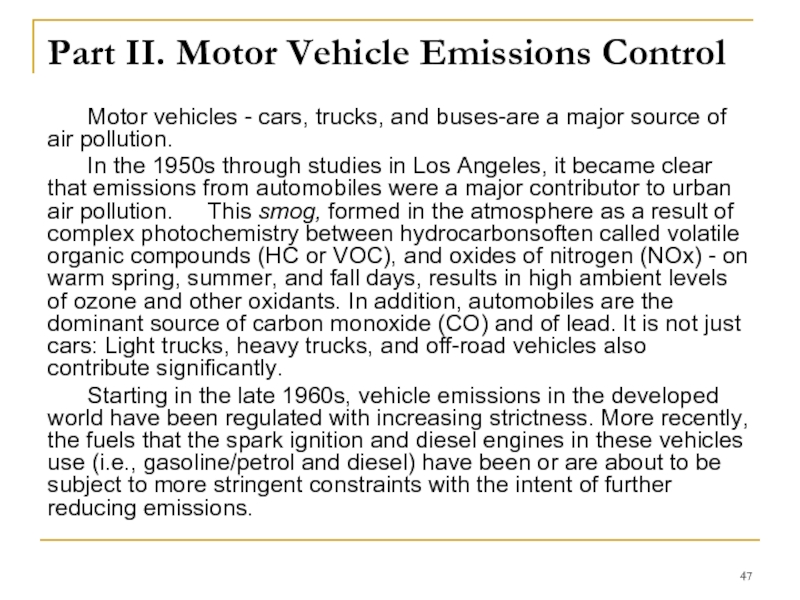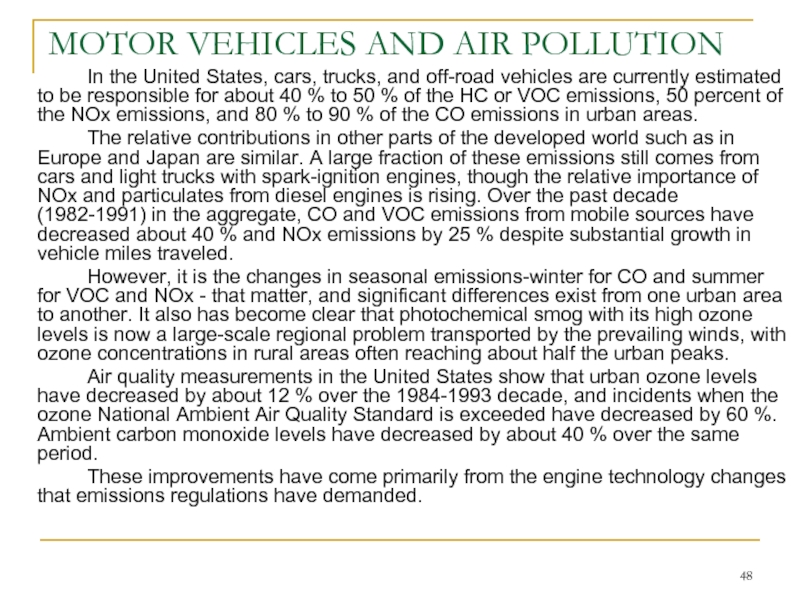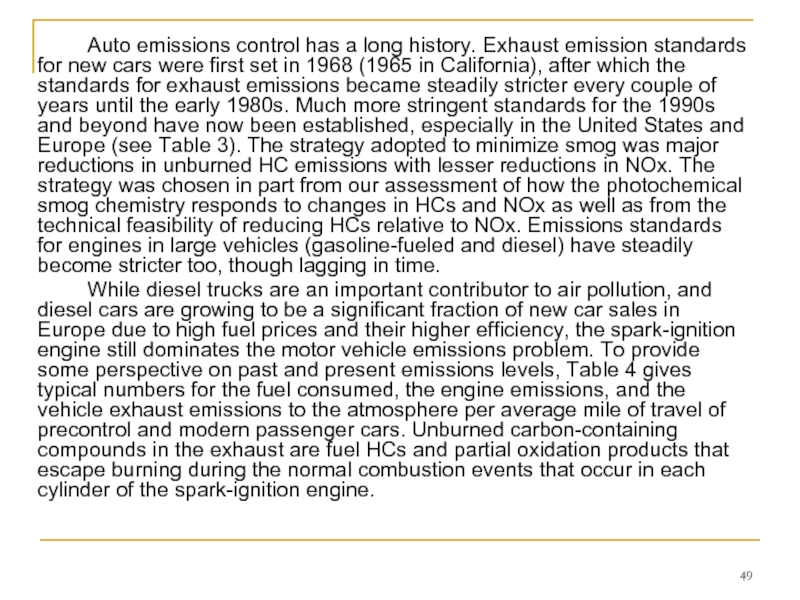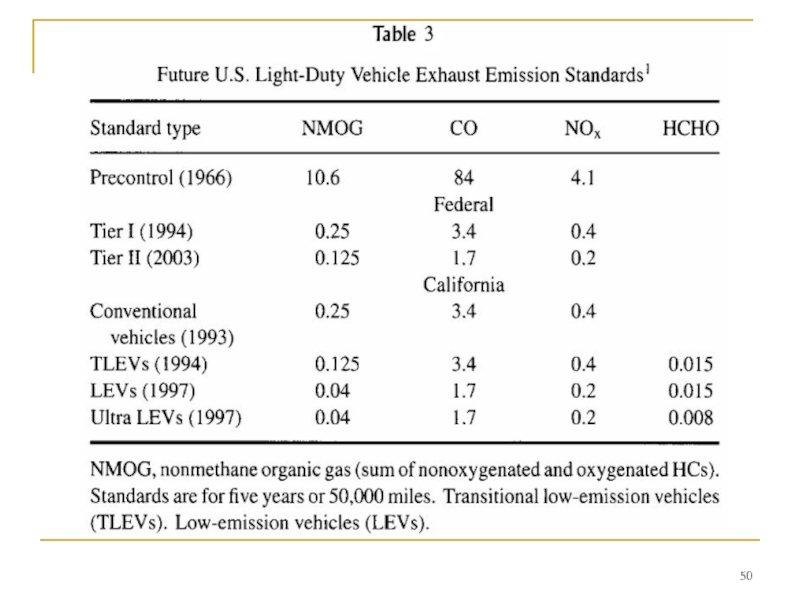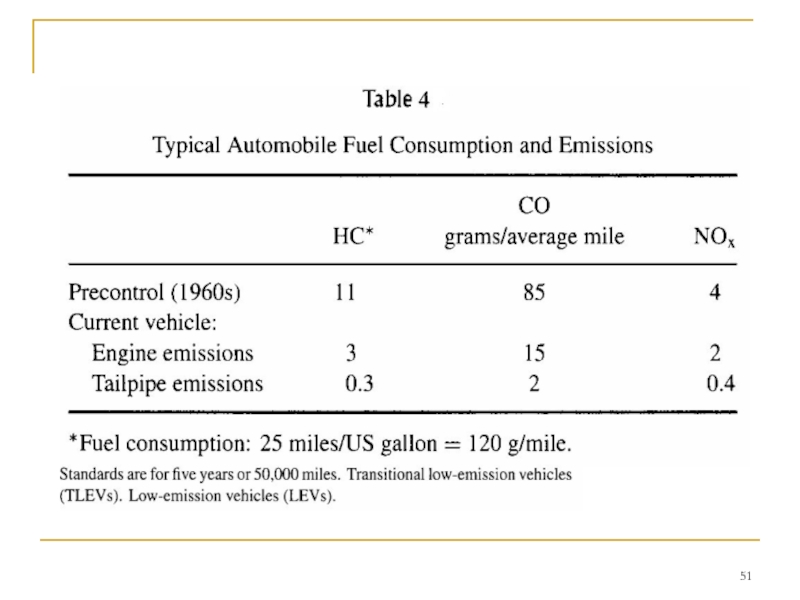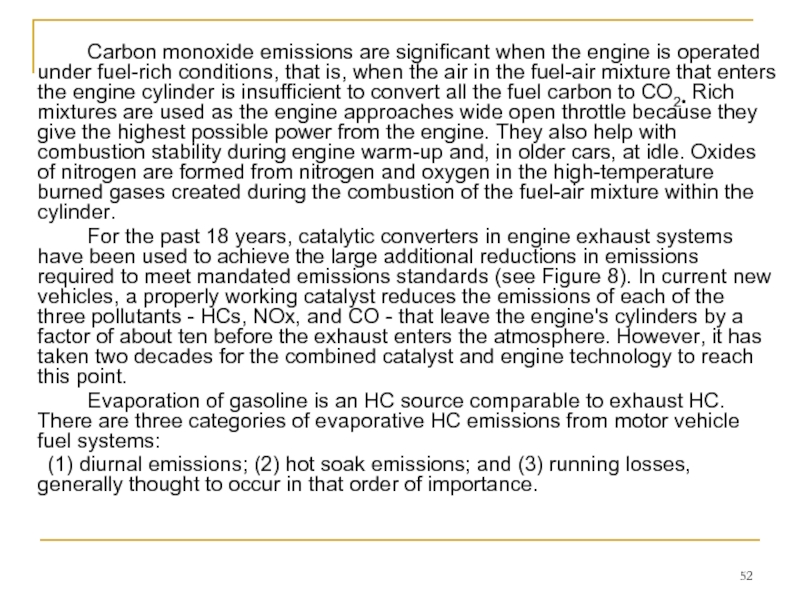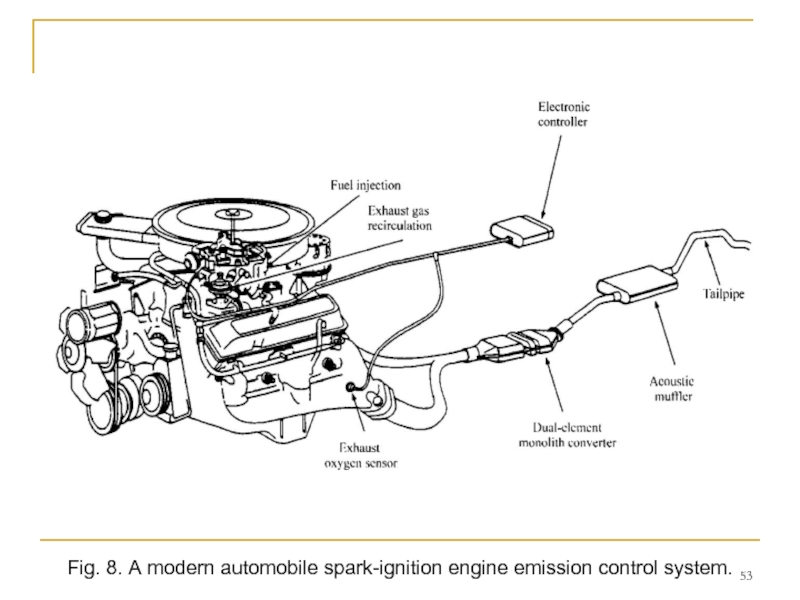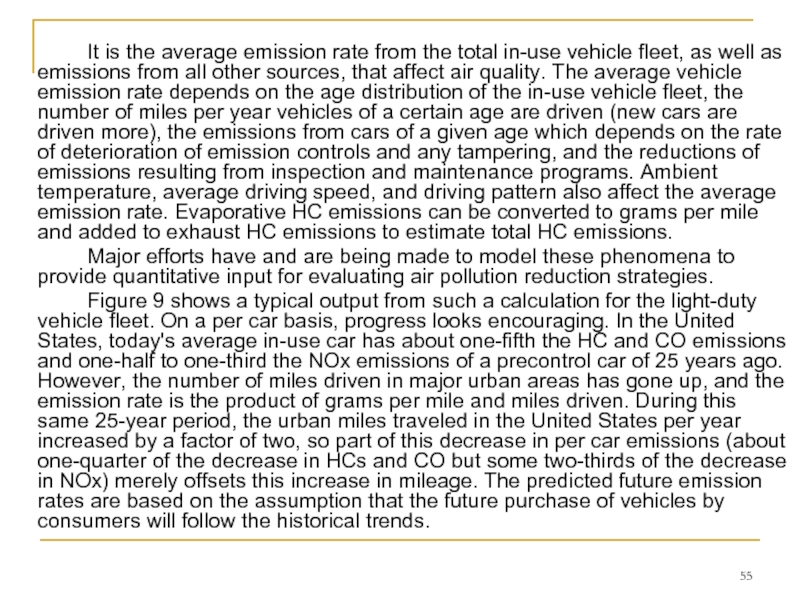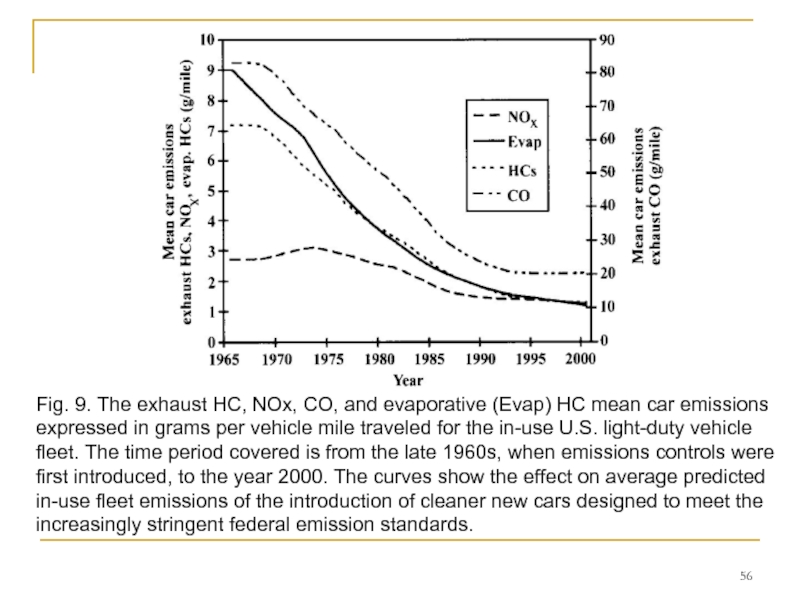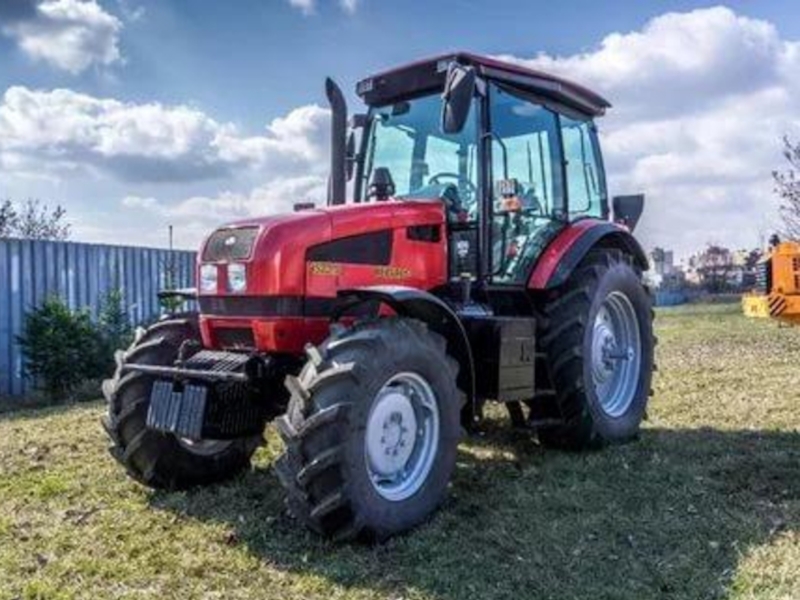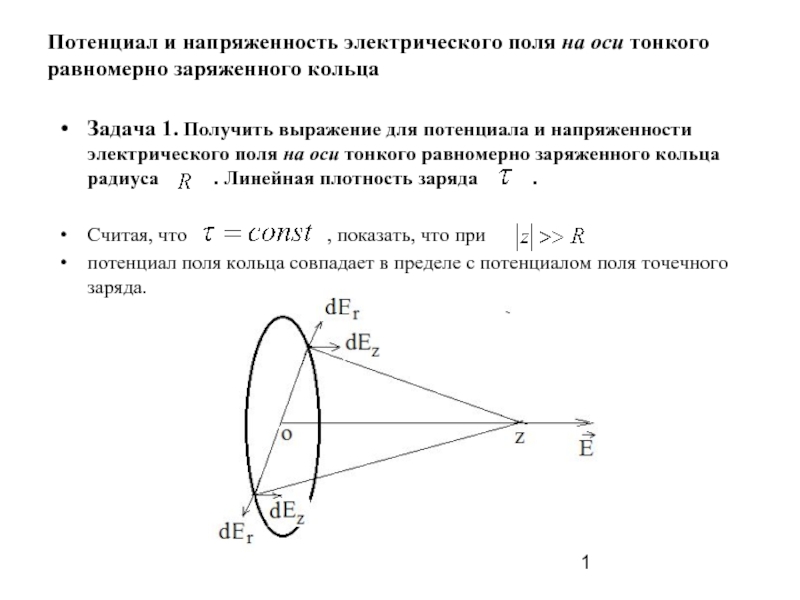- Главная
- Разное
- Дизайн
- Бизнес и предпринимательство
- Аналитика
- Образование
- Развлечения
- Красота и здоровье
- Финансы
- Государство
- Путешествия
- Спорт
- Недвижимость
- Армия
- Графика
- Культурология
- Еда и кулинария
- Лингвистика
- Английский язык
- Астрономия
- Алгебра
- Биология
- География
- Детские презентации
- Информатика
- История
- Литература
- Маркетинг
- Математика
- Медицина
- Менеджмент
- Музыка
- МХК
- Немецкий язык
- ОБЖ
- Обществознание
- Окружающий мир
- Педагогика
- Русский язык
- Технология
- Физика
- Философия
- Химия
- Шаблоны, картинки для презентаций
- Экология
- Экономика
- Юриспруденция
Internal сombustion engine. The fuels and emissions control. Engine fuels презентация
Содержание
- 1. Internal сombustion engine. The fuels and emissions control. Engine fuels
- 2. Part I. Thermochemistry and Fuels This
- 3. Combustion Reactions Most IC engines obtain their
- 4. SI engines have a combustion efficiency in
- 5. HYDROCARBON FUELS - GASOLINE The main fuel
- 6. Generally, the larger the molecular weight of
- 7. The crude oil from some petroleum fields
- 8. A small percentage of components that vaporize
- 9. If different commercial brands of gasoline are
- 10. SOME COMMON HYDROCARBON COMPONENTS Carbon atoms form
- 15. SELF-IGNITION Self-Ignition Characteristics of Fuels If the
- 16. Figure 3 Self-ignition characteristics of fuels.
- 17. Ignition delay is generally a very small
- 18. For illustrative reasons, a combustion chamber can
- 19. Figure 6 SI engine combustion chamber schematically
- 20. On the other hand, a high compression
- 21. Octane Number The fuel property that describes
- 23. To find the ON of a fuel,
- 24. Fuel Sensitivity Because the test engine has
- 25. The higher the flame speed in an
- 26. DIESEL FUEL Diesel fuel (diesel oil, fuel
- 27. Another method of classifying diesel fuel to
- 28. Cetane Number In a compression ignition engine,
- 29. A special CI test engine is used
- 30. ALTERNATE FUELS Sometime during the 21st century,
- 31. Vast improvements have been made in
- 32. Only when extensive research and development is
- 33. Alcohol Alcohols are an attractive alternate
- 34. The disadvantages of alcohol fuels include: 1.
- 35. *HHV/LHV - Higher heating value/Lower heating value
- 36. 4. Poor cold weather starting characteristics due
- 37. Methanol Of all the fuels being considered
- 38. Methanol can be obtained from many sources,
- 39. Ethanol Ethanol has been used as automobile
- 40. Hydrogen A number of companies have built
- 41. Disadvantages of using hydrogen as a fuel:
- 42. Natural Gas-Methane Natural gas is a mixture
- 43. Advantages of natural gas as a fuel
- 44. Propane Propane has been tested in
- 45. Other Fuels Attempts to use many other
- 46. CONCLUSIONS on Part I For most of
- 47. Part II. Motor Vehicle Emissions Control Motor
- 48. MOTOR VEHICLES AND AIR POLLUTION In the
- 49. Auto emissions control has a long history.
- 52. Carbon monoxide emissions are significant when the
- 53. Fig. 8. A modern automobile spark-ignition engine emission control system.
- 54. Diurnal emissions take place as the fuel
- 55. It is the average emission rate from
- 56. Fig. 9. The exhaust HC, NOx, CO,
Слайд 2Part I. Thermochemistry and Fuels
This chapter reviews basic thermochemistry principles as
Gasoline and other possible alternate fuels are examined.
Слайд 3Combustion Reactions
Most IC engines obtain their energy from the combustion of
Stoichiometric oxygen (sometimes called theoretical oxygen) is just enough to convert all carbon in the fuel to CO2 and all hydrogen to H20, with no oxygen left over. The balanced chemical equation of the simplest hydrocarbon fuel, methane CH4, burning with stoichiometric oxygen is:
CH4 + 2O2 ~ CO2 + 2H2O
It takes two moles of oxygen to react with one mole of fuel, and this gives one mole of carbon dioxide and two moles of water vapor.
Слайд 4 SI engines have a combustion efficiency in the range of 95%
CI engines operate lean overall and typically have combustion efficiencies of about 98%. When an engine operates fuel rich, there is not enough oxygen to react with all the fuel, and combustion efficiency decreases.
Even when the flow of air and fuel into an engine is controlled exactly at stoichiometric conditions, combustion will not be "perfect," and components other than CO2, H2O, and N2 are found in the exhaust products.
One major reason for this is the extremely short time available for each engine cycle, which often means that less than complete mixing of the air and fuel is obtained. Some fuel molecules do not find an oxygen molecule to react with, and small quantities of both fuel and oxygen end up in the exhaust.
Figure 1 Combustion efficiency as a function of fuel equivalence ratio. Efficiency for engines operating lean is generally on the order of 98%
Слайд 5HYDROCARBON FUELS - GASOLINE
The main fuel for SI engines is gasoline,
Crude oil was first discovered in Pennsylvania in 1859, and the fuel product line generated from it developed along with the development of the IC engine. Crude oil is made up almost entirely of carbon and hydrogen with some traces of other species. It varies from 83% to 87% carbon and 11% to 14% hydrogen by weight. The carbon and hydrogen can combine in many ways and form many different molecular compounds. One test of a crude oil sample identified over 25,000 different hydrocarbon components.
The crude oil mixture which is taken from the ground is separated into component products by cracking and/or distillation using thermal or catalytic methods at an oil refinery.
Cracking is the process of breaking large molecular components into more useful components of smaller molecular weight. Preferential distillation is used to separate the mixtures into single components or smaller ranges of components.
Слайд 6 Generally, the larger the molecular weight of a component, the higher
automobile gasoline
diesel fuel
aircraft gasoline
jet fuel
home heating fuel
industrial heating fuel
natural gas
lubrication oil
asphalt
alcohol
rubber
paint
plastics
explosives and etc.
Слайд 7 The crude oil from some petroleum fields in the Mideast is
Figure 2 shows a temperature-vaporization curve for a typical gasoline mixture. The various components of different molecular weights will vaporize at different temperatures, small molecular weights boiling at low temperature and larger molecular weights at higher temperature. This makes a very desirable fuel.
The availability and cost of gasoline fuel, then, is a result of a market competition with many other products. This becomes more critical with the depletion of the earth's crude oil reserves, which looms on the horizon.
Crude oil obtained from different parts of the world contain different amounts and combinations of hydrocarbon species. In the United States, two general classifications are identified:
Pennsylvania crude and western crude.
Pennsylvania crude has a high concentration of paraffins with little or no asphalt, while western crude has an asphalt base with little paraffin.
Figure 2 Temperature-vaporization curve for a typical gasoline mixture. Fifty percent of the gasoline would be vaporized at 81°C
Слайд 8 A small percentage of components that vaporize (boil) at low temperature
However, too much of this front-end volatility can cause problems when the fuel vaporizes too quickly. Volumetric efficiency of the engine will be reduced if fuel vapor replaces air too early in the intake system. Another serious problem this can cause is vapor lock, which occurs when fuel vaporizes in the fuel supply lines or in the carburetor in the hot engine compartment. When this happens, the supply of fuel is cut off and the engine stops.
Figure 2 Temperature-vaporization curve for a typical gasoline mixture. Fifty percent of the gasoline would be vaporized at 81°C
A large percent of fuel should be vaporized at the normal intake system temperature during the short time of the intake process. To maximize volumetric efficiency, some of the fuel should not vaporize until late into the compression stroke and even into the start of combustion. This is why some high-molecular-weight components are included in gasoline mixtures. If too much of this high-end volatility is included in the gasoline, however, some of the fuel never gets vaporized and ends up as exhaust pollution or condenses on the cylinder walls and dilutes the lubricating oil.
Слайд 9 If different commercial brands of gasoline are compared, there is found
Figure 2 Temperature-vaporization curve for a typical gasoline mixture. Fifty percent of the gasoline would be vaporized at 81°C
One way that is sometimes used to describe a gasoline is to use three temperatures:
the temperature at which 10% is vaporized,
at which 50% is vaporized, and
at which 90% is vaporized.
The gasoline in Fig. 2 could therefore be classified as 57-81-103°C.
Слайд 10SOME COMMON HYDROCARBON COMPONENTS
Carbon atoms form four bonds in molecular structures,
A number of different families of hydrocarbon molecules have been identified; a few of the more common ones are described.
Paraffins
The paraffin family (sometimes called alkanes) are chain molecules with a carbon-hydrogen combination of CnH2n+ 2, n being any number. The simplest member of this family, and the simplest of all stable hydrocarbon molecules, is methane (CH4), which is the main component of natural gas. It can be pictured as:
Слайд 15SELF-IGNITION
Self-Ignition Characteristics of Fuels
If the temperature of an air-fuel mixture is
The temperature above which this occurs is called the self-ignition temperature (SIT). This is the basic principle of ignition in a compression ignition engine. The compression ratio is high enough so that the temperature rises above SIT during the compression stroke. Selfignition then occurs when fuel is injected into the combustion chamber.
On the other hand, self-ignition (or pre-ignition, or auto-ignition) is not desirable in an SI engine, where a spark plug is used to ignite the air-fuel at the proper time in the cycle. The compression ratios of gasoline-fueled SI engines are limited to about 12:1 to avoid self-ignition. When self-ignition does occur in an SI engine higher than desirable, pressure pulses are generated. These high pressure pulses can cause damage to the engine and quite often are in the audible frequency range. This phenomenon is often called knock or ping.
Слайд 16Figure 3 Self-ignition characteristics of fuels.
Figure 3 shows the basic
If the temperature of a fuel is raised above the self-ignition temperature (SIT), the fuel will spontaneously ignite after a short ignition delay (ID) time. Ignition delay is generally on the order of thousandths of a second.
The higher the initial temperature rise above SIT, the shorter will be ID. The values for SIT and ID for a given air-fuel mixture are ambiguous, depending on many variables which include temperature, pressure, density, turbulence, swirl, fuel-air ratio, presence of inert gases, etc.
Слайд 17 Ignition delay is generally a very small fraction of a second.
Figure 4 shows the pressure-time history within a cylinder of a typical SI engine. With no self-ignition the pressure force on the piston follows a smooth curve, resulting in smooth engine operation. When self-ignition does occur, pressure forces on the piston are not smooth and engine knock occurs.
Figure 4 Cylinder pressure as a function of time in a typical SI engine combustion chamber showing (a) normal (b) light knock (c) heavy knock combustion
Слайд 18 For illustrative reasons, a combustion chamber can be visualized schematically as
These ideas can then be extrapolated to real combustion engine shapes. Before combustion the chamber is divided into four equal mass units, each occupying an equal volume. Combustion starts at the spark plug on the left side, and the flame front travels from left to right. As combustion occurs, the temperature of the burned gases is increased to a high value. This, in turn, raises the pressure of the burned gases and expands the volume of that mass as shown in Fig. 5 (b). The unburned gases in front of the flame front are compressed by this higher pressure, and compressive heating raises the temperature of the gas. The temperature of the unburned gas is further raised by radiation heating from the flame, and this then raises the pressure even higher. Heat transfer by conduction and convection are not important during this process due to the very short time interval involved.
Figure 5 SI engine combustion chamber schematically visualized as long hollow cylinder with the spark plug located at left end
Слайд 19Figure 6 SI engine combustion chamber schematically visualized further compresses and
The flame front moving through the second mass of air-fuel does so at an
accelerated rate because of the higher temperature and pressure, which increase the reaction rate. This, in turn, further compresses and heats the unburned gases in front of the flame as shown in Fig. 6. In addition, the energy release in the combustion process raises further the temperature and pressure of the burned gases behind the flame front. This occurs both by compressive heating and radiation. Thus, the flame front continues its travel through an unburned mixture that is progressively higher in temperature and pressure. By the time the flame reaches the last portion of unburned gas, this gas is at a very high temperature and pressure. In this end gas near the end of the combustion process is where self-ignition and knock occur.
To avoid knock, it is necessary for the flame to pass through and consume all unburned gases which have risen above self-ignition temperature before the ignition delaytime elapses. This is done by a combination of fuel property control and design of
combustion chamber geometry.
Слайд 20 On the other hand, a high compression ratio will result in
Figure 6 SI engine combustion chamber schematically visualized as further compresses and heats the unburned gases in front of the flame
At the end of the combustion process, the hottest region in the cylinder is near the spark plug where combustion was initiated. This region became hot at the start of combustion and then continued to increase in temperature due to compressive heating and radiation as the flame front passed through the rest of the combustion chamber. By limiting the compression ratio in an SI engine, the temperature at the end of the compression stroke where combustion starts is limited. The reduced temperature at the start of combustion then reduces the temperature throughout the entire combustion process, and knock is avoided.
Слайд 21Octane Number
The fuel property that describes how well a fuel will
There are several different tests used for rating octane numbers, each of which will give a slightly different ON value. The two most common methods of rating gasoline and other automobile SI fuels are the Motor Method and the Research Method. These give the motor octane number (MON) and research octane number (RON).
The engine used to measure MON and RON is a single-cylinder, overhead valve engine that operates on the four-stroke Otto cycle. It has a variable compression ratio which can be adjusted from 3 to 30. Test conditions to measure MON and RON are given in Table 1.
Слайд 23 To find the ON of a fuel, the following test procedure
The test engine is run at specified conditions using the fuel being tested. Compression ratio is adjusted until a standard level of knock is experienced. The test fuel is then replaced with a mixture of the two standard fuels. The intake system of the engine is designed such that the blend of the two standard fuels can be varied to any percent from all isooctane to all n-heptane. The blend of fuels is varied until the same knock characteristics are observed as with the test fuel. The percent of isooctane in the fuel blend is the ON given to the test fuel.
For instance, a fuel that has the same knock characteristics as a blend of 87% isooctane and 13% n-heptane would have an ON of 87.
On the fuel pumps at an automobile service station is found the anti-knock index:
AKI = (MON + RON) / 2
This is often referred to as the octane number of the fuel.
Octane Number
Слайд 24Fuel Sensitivity
Because the test engine has a combustion chamber designed in
Operating conditions used to measure MON are more severe than those used to measure RON. Some fuels, therefore, will have a RON greater than MON. The difference between these is called fuel sensitivity:
FS = RON – MON
Fuel sensitivity is a good measure of how sensitive knock characteristics of a fuel will be to engine geometry. A low FS number will usually mean that knock characteristics of that fuel are insensitive to engine geometry. FS numbers generally range from 0 to 10.
For measuring octane numbers above 100, fuel additives are mixed with isooctane and other standard points are established. A common additive used for many years to raise the octane number of a fuel was tetraethyllead (TEL).
Слайд 25 The higher the flame speed in an air-fuel mixture, the higher
The octane number of a fuel depends on a number of variables, some of which are not fully understood. Things that affect ON are combustion chamber geometry, turbulence, swirl, temperature, inert gases, etc. This can be seen by the difference in RON and MON for some fuels, brought about by different operating characteristics of the test engine.
Figure 7 Critical compression ratio as a function of fuel octane number (anti-knock index) used in an engine
Слайд 26DIESEL FUEL
Diesel fuel (diesel oil, fuel oil) is obtainable over a
Generally speaking, the greater the refining done on a sample of fuel, the lower is its molecular weight, the lower is its viscosity, and the greater is its cost. Numerical scales usually range from one (1) to five (5) or six (6), with subcategories using alphabetical letters (e.g., A1, 2D, etc).
The lowest numbers have the lowest molecular weights and lowest viscosity. These are the fuels typically used in CI engines. Higher numbered fuels are used in residential heating units and industrial furnaces. Fuels with the largest numbers are very viscous and can only be used in large, massive heating units. Each classification has acceptable limits set on various physical properties, such as viscosity, flash point, pour point, cetane number, sulfur content, etc.
Слайд 27 Another method of classifying diesel fuel to be used in internal
For convenience, diesel fuels for IC engines can be divided into two extreme categories:
- light diesel fuel has a molecular weight of about 170 and
- heavy diesel fuel has a molecular weight of about 200.
Most diesel fuel used in engines will fit in this range. Light diesel fuel will be less viscous and easier to pump, will generally inject into smaller droplets, and will be more costly. Heavy diesel fuel can generally be used in larger engines with higher injection pressures and heated intake systems. Often an automobile or light truck can use a less costly heavier fuel in the summer, but must change to a lighter, less viscous fuel in cold weather because of cold starting and fuel line pumping problems.
Classification of diesel fuel
Слайд 28Cetane Number
In a compression ignition engine, self-ignition of the air-fuel mixture
The larger the cetane number, the shorter is the ID (ignition delay) and the quicker the fuel will self-ignite in the combustion chamber environment. A low cetane number means the fuel will have a long ID.
Like octane number rating, cetane numbers are established by comparing the test fuel to two standard reference fuels. The fuel component n-cetane (hexade-cane), C16H34,is given the cetane number value of 100, while heptamethylnonane (HMN), C12H34,is given the value of 15.
The cetane number (CN) of other fuels is then obtained by comparing the ID of that fuel to the ID of a mixture blend of the two reference fuels with
CN = (percent of n-cetane) + (0.15)(percent of HMN)
Слайд 29 A special CI test engine is used which has the capability
The difficulty of this method, in addition to requiring a costly test engine, is to be able to recognize the precise moment when combustion starts. The very slow rise in pressure at the start of combustion is very difficult to detect.
Normal cetane number range is about 40 to 60.
For a given engine injection timing and rate, if the cetane number of the fuel is low the ID will be too long. When this occurs, more fuel than, desirable will be injected into the cylinder before the first fuel particles ignite, causing a very large, fast pressure rise at the start of combustion. This results in low thermal efficiency and a rough-running engine.
If the CN of the fuel is high, combustion will start too soon in the cycle. Pressure will rise before TDC, and more work will be required in the compression stroke.
Cetane numbers below 40 result in unacceptable levels of exhaust smoke and are illegal by many emission laws. The cetane number of a fuel can be raised with certain additives which include nitrates and nitrites.
Слайд 30ALTERNATE FUELS
Sometime during the 21st century, crude oil and petroleum products
Although there have always been some IC engines fueled with non-gasoline or diesel oil fuels, their numbers have been relatively small. Because of the high cost of petroleum products, some third-world countries have for many years been using manufactured alcohol as their main vehicle fuel.
Many pumping stations on natural gas pipelines use the pipeline gas to fuel the engines driving the pumps. This solves an otherwise complicated problem of delivering fuel to the pumping stations, many of which are in very isolated regions. Some large displacement engines have been manufactured especially for pipeline work. These consist of a bank of engine cylinders and a bank of compressor cylinders connected to the same crankshaft and contained in a single engine block similar to a V-style engine.
Another reason motivating the development of alternate fuels for the IC engine is concern over the emission problems of gasoline engines. Combined with other air-polluting systems, the large number of automobiles is a major contributor to the air quality problem of the world.
Слайд 31
Vast improvements have been made in reducing emissions given off by
A third reason for alternate fuel development in the United States and other industrialized countries is the fact that a large percentage of crude oil must be imported from other countries which control the larger oil fields. In recent years, up to a third of the United States foreign trade deficit has been from the purchase of crude oil, tens of billions of dollars.
Listed next are the major alternate fuels that have been and are being considered and tested for possible high-volume use in automobile and other kinds of IC engines. These fuels have been used in limited quantities in automobiles and small trucks and vans. Quite often, fleet vehicles have been used for testing (e.g., taxies, delivery vans, utility company trucks). This allows for comparison testing with similar gasoline-fueled vehicles, and simplifies fueling of these vehicles.
It must be remembered that, in just about all alternate fuel testing, the engines used are modified engines which were originally designed for gasoline fueling. They are, therefore, not the optimum design for the other fuels.
Слайд 32 Only when extensive research and development is done over a period
Some diesel engines are starting to appear on the market which use dual fuel. They use methanol or natural gas and a small amount of diesel fuel that is injected at the proper time to ignite both fuels.
Most alternate fuels are very costly at present. This is often because of the quantity used. Many of these fuels will cost much less if the amount of their usage gets to the same order of magnitude as gasoline. The cost of manufacturing, distribution, and marketing all would be less.
Another problem with alternate fuels is the lack of distribution points (service stations) where the fuel is available to the public. The public will be reluctant to purchase an automobile unless there is a large-scale network of service stations available where fuel for that automobile can be purchased. On the other hand, it is difficult to justify building a network of these service stations until there are enough automobiles to make them profitable. Some cities are starting to make available a few distribution points for some of these fuels, like propane, natural gas, and methanol. The transfer from one major fuel type to another will be a slow, costly, and sometimes painful process.
In the following list, some of the drawbacks for a particular fuel may become less of a problem if large quantities of that fuel are used (i.e., cost, distribution, etc.)
Слайд 33Alcohol
Alcohols are an attractive alternate fuel because they can be obtained
The advantages of alcohol as a fuel include:
1. Can be obtained from a number of sources, both natural and manufactured.
2. Is high octane fuel with anti-knock index numbers (octane number on fuel pump) of over 100. High octane numbers result, at least in part, from the high flame speed of alcohol. Engines using high-octane fuel can run more efficiently by using higher compression ratios.
3. Generally less overall emissions when compared with gasoline.
4. When burned, it forms more moles of exhaust, which gives higher pressure and more power in the expansion stroke.
5. Has high evaporative cooling which results in a cooler intake process and compression stroke. This raises the volumetric efficiency of the engine and reduces the required work input in the compression stroke.
6. Low sulfur content in the fuel.
Слайд 34 The disadvantages of alcohol fuels include:
1. Low energy content of the
2. More aldehydes in the exhaust. If as much alcohol fuel was consumed as gasoline, aldehyde emissions would be a serious exhaust pollution problem.
3. Alcohol is much more corrosive than gasoline on copper, brass, aluminum, rubber, and many plastics. This puts some restrictions on the design and manufacturing of engines to be used with this fuel. This should also be considered when alcohol fuels are used in engine systems designed to be used with gasoline. Fuel lines and tanks, gaskets, and even metal engine parts can deteriorate with long-term alcohol use (resulting in cracked fuel lines, the need for special fuel tank, etc). Methanol is very corrosive on metals.
Слайд 36 4. Poor cold weather starting characteristics due to low vapor pressure
5. Poor ignition characteristics in general.
6. Alcohols have almost invisible flames, which is considered dangerous when handling fuel. Again, a small amount of gasoline removes this danger.
7. Danger of storage tank flammability due to low vapor pressure. Air can leak into storage tanks and create a combustible mixture.
8. Low flame temperatures generate less NOx, but the resulting lower exhaust temperatures take longer to heat the catalytic converter to an efficient operating temperature.
9. Many people find the strong odor of alcohol very offensive. Headaches and dizziness have been experienced when refueling an automobile.
10. Vapor lock in fuel delivery systems.
The disadvantages of alcohol fuels include:
Слайд 37Methanol
Of all the fuels being considered as an alternate to gasoline,
One problem with gasoline-alcohol mixtures as a fuel is the tendency for alcohol to combine with any water present. When this happens the alcohol separates locally from the gasoline, resulting in a non-homogeneous mixture. This causes the engine to run erratically due to the large AF differences between the two fuels.
At least one automobile company has been experimenting with a three-fuel vehicle which can use any combination of gasoline-methanol-ethanol.
Слайд 38 Methanol can be obtained from many sources, both fossil and renewable.
In some parts of the country, M10 fuel (10% methanol and 90% gasoline) is now sold at some local service stations in place of gasoline. It is advisable to read the sometimes small print on the fuel pump to determine the type of fuel that is being used in your automobile.
Emissions from an engine using M10 fuel are about the same as those using gasoline. The advantage (and disadvantage) of using this fuel is mainly the 10% decrease in gasoline use. With M85 fuel there is a measurable decrease in HC and CO exhaust emissions. However, there is an increase in NOx and a large (= 500%) increase in formaldehyde formation.
Methanol is used in some dual-fuel CI engines. Methanol by itself is not a good CI fuel because of its high octane number, but if a small amount of diesel oil is used for ignition, it can be used with good results. This is very attractive for third-world countries, where methanol can often be obtained much cheaper than diesel oil. Older CI bus engines have been converted to operate on methanol in tests conducted in California. This resulted in an overall reduction of harmful emissions compared with worn engines operating with diesel fuel.
Слайд 39Ethanol
Ethanol has been used as automobile fuel for many years in
Ethanol can be made from ethylene or from fermentation of grains and sugar. Much of it is made from corn, sugar beets, sugar cane, and even cellulose (wood and paper). In the United States, corn is the major source. The present cost of ethanol is high due to the manufacturing and processing required. This would be reduced if larger amounts of this fuel were used. However, very high production would create a food-fuel competition, with resulting higher costs for both. Some studies show that at present in the United States, crops grown for the production of ethanol consume more energy in plowing, planting, harvesting, fermenting, and delivery than what is in the final product. This defeats one major reason for using an alternate fuel.
Ethanol has less HC emissions than gasoline but more than methanol.
Слайд 40Hydrogen
A number of companies have built automobiles with prototype or modified
The advantages of hydrogen as a IC engine fuel include:
1. Low emissions. Essentially no CO or HC in the exhaust as there is no carbon
in the fuel. Most exhaust would be H2O and N2.
2. Fuel availability. There are a number of different ways of making hydrogen,
including electrolysis of water.
3. Fuel leakage to environment is not a pollutant.
4. High energy content per volume when stored as a liquid. This would give a
large vehicle range for a given fuel tank capacity, but see the following.
Слайд 41 Disadvantages of using hydrogen as a fuel:
1. Heavy, bulky fuel storage,
2. Difficult to refuel.
3. Poor engine volumetric efficiency. Any time a gaseous fuel is used in an engine, the fuel will displace some of the inlet air and poorer volumetric efficiency will result.
4. Fuel cost would be high at present-day technology and availability.
5. High NOx emissions because of high flame temperature.
6. Can detonate.
At least one automobile company (Mazda) has adapted a rotary Wankel engine to run on hydrogen fuel. It was reasoned that this is a good type of engine for this fuel. The fuel intake is on the opposite side of the engine from where combustion occurs, lowering the chance of pre-ignition from a hot engine block; hydrogen fuel ignites very easily. This same experimental car uses a metal-hydride fuel storage system.
Слайд 42Natural Gas-Methane
Natural gas is a mixture of components, consisting mainly of
Its sulfur content ranges from very little (sweet) to larger amounts (sour).
It is stored as compressed natural gas (CNG) at pressures of 16 to 25 MPa, or as liquid natural gas (LNG) at pressures of 70 to 210 kPa and a temperature around -160°C.
As a fuel, it works best in an engine system with a single-throttle body fuel injector. This gives a longer mixing time, which is needed by this fuel. Tests using CNG in various sized vehicles continue to be conducted by government agencies and private industry.
Слайд 43 Advantages of natural gas as a fuel include:
1. Octane number of
2. Low engine emissions. Less aldehydes than with methanol.
3. Fuel is fairly abundant worldwide. It can be made from coal but this would make it more costly.
Disadvantages of natural gas as an engine fuel:
1. Low energy density resulting in low engine performance.
2. Low engine volumetric efficiency because it is a gaseous fuel.
3. Need for large pressurized fuel storage tank. Most test vehicles have a range of only about 120 miles. There is some safety concern with a pressurized fuel tank.
4. Inconsistent fuel properties.
5. Refueling is slow process.
Some very large stationary CI engines operate on a fuel combination of methane and diesel fuel. Methane is the major fuel, amounting to more than 90% of the total. It is supplied to the engine as a gas through high-pressure pipes. A small amount of high grade, low sulfur diesel fuel is used for ignition purposes. The net result is very clean running engines. These engines would also be good power plants for large ships, except that high-pressure gas pipes are undesirable on ships.
Слайд 44Propane
Propane has been tested in fleet vehicles for a number of
Propane is stored as a liquid under pressure and delivered through a high-pressure line to the engine, where it is vaporized. Being a gaseous fuel, it has the disadvantage of lower engine volumetric efficiency.
Слайд 45Other Fuels
Attempts to use many other types of fuel have been
At present, a number of biomass fuels are being evaluated, mainly in Europe. These include CI fuel oil made from wood, barley, soy beans, rape seed, and even beef tallow. Advantages of these fuels generally include availability and low cost, low sulfur, and low emissions. Disadvantages include low energy content (heating value) and corresponding high specific fuel consumption.
Слайд 46CONCLUSIONS on Part I
For most of the 20th century, the two
In the latter part of the century, alcohol fuels made from various farm products and other sources have become increasingly more important, both in the United States and in other countries. With increasing air pollution problems and a petroleum shortage looming on the horizon, major research and development programs are being conducted throughout the world to find suitable alternate fuels to supply engine needs for the coming decades.
Слайд 47Part II. Motor Vehicle Emissions Control
Motor vehicles - cars, trucks, and
In the 1950s through studies in Los Angeles, it became clear that emissions from automobiles were a major contributor to urban air pollution. This smog, formed in the atmosphere as a result of complex photochemistry between hydrocarbonsoften called volatile organic compounds (HC or VOC), and oxides of nitrogen (NOx) - on warm spring, summer, and fall days, results in high ambient levels of ozone and other oxidants. In addition, automobiles are the dominant source of carbon monoxide (CO) and of lead. It is not just cars: Light trucks, heavy trucks, and off-road vehicles also contribute significantly.
Starting in the late 1960s, vehicle emissions in the developed world have been regulated with increasing strictness. More recently, the fuels that the spark ignition and diesel engines in these vehicles use (i.e., gasoline/petrol and diesel) have been or are about to be subject to more stringent constraints with the intent of further reducing emissions.
Слайд 48MOTOR VEHICLES AND AIR POLLUTION
In the United States, cars, trucks, and
The relative contributions in other parts of the developed world such as in Europe and Japan are similar. A large fraction of these emissions still comes from cars and light trucks with spark-ignition engines, though the relative importance of NOx and particulates from diesel engines is rising. Over the past decade (1982-1991) in the aggregate, CO and VOC emissions from mobile sources have decreased about 40 % and NOx emissions by 25 % despite substantial growth in vehicle miles traveled.
However, it is the changes in seasonal emissions-winter for CO and summer for VOC and NOx - that matter, and significant differences exist from one urban area to another. It also has become clear that photochemical smog with its high ozone levels is now a large-scale regional problem transported by the prevailing winds, with ozone concentrations in rural areas often reaching about half the urban peaks.
Air quality measurements in the United States show that urban ozone levels have decreased by about 12 % over the 1984-1993 decade, and incidents when the ozone National Ambient Air Quality Standard is exceeded have decreased by 60 %. Ambient carbon monoxide levels have decreased by about 40 % over the same period.
These improvements have come primarily from the engine technology changes that emissions regulations have demanded.
Слайд 49 Auto emissions control has a long history. Exhaust emission standards for
While diesel trucks are an important contributor to air pollution, and diesel cars are growing to be a significant fraction of new car sales in Europe due to high fuel prices and their higher efficiency, the spark-ignition engine still dominates the motor vehicle emissions problem. To provide some perspective on past and present emissions levels, Table 4 gives typical numbers for the fuel consumed, the engine emissions, and the vehicle exhaust emissions to the atmosphere per average mile of travel of precontrol and modern passenger cars. Unburned carbon-containing compounds in the exhaust are fuel HCs and partial oxidation products that escape burning during the normal combustion events that occur in each cylinder of the spark-ignition engine.
Слайд 52 Carbon monoxide emissions are significant when the engine is operated under
For the past 18 years, catalytic converters in engine exhaust systems have been used to achieve the large additional reductions in emissions required to meet mandated emissions standards (see Figure 8). In current new vehicles, a properly working catalyst reduces the emissions of each of the three pollutants - HCs, NOx, and CO - that leave the engine's cylinders by a factor of about ten before the exhaust enters the atmosphere. However, it has taken two decades for the combined catalyst and engine technology to reach this point.
Evaporation of gasoline is an HC source comparable to exhaust HC. There are three categories of evaporative HC emissions from motor vehicle fuel systems:
(1) diurnal emissions; (2) hot soak emissions; and (3) running losses, generally thought to occur in that order of importance.
Слайд 54 Diurnal emissions take place as the fuel tank of a parked
Running losses can occur as gasoline vapors are expelled from the fuel tank while the car is driven and the fuel in the tank becomes hot. These losses can be high at high ambient temperatures or if the fuel system becomes particularly hot while running. Finally, gasoline vapor can escape from the fuel tank when a vehicle is filled at the service station. Evaporative HCs have been captured with carbon-containing canisters designed to absorb the gasoline vapors from these sources, as air is vented from the fuel system. The absorbed vapors are purged from the canister into the engine and burned during normal driving. While these evaporative controls have met the test requirements for two decades, many of these systems have not been nearly as effective at controlling evaporative emissions in the field.
Слайд 55 It is the average emission rate from the total in-use vehicle
Major efforts have and are being made to model these phenomena to provide quantitative input for evaluating air pollution reduction strategies.
Figure 9 shows a typical output from such a calculation for the light-duty vehicle fleet. On a per car basis, progress looks encouraging. In the United States, today's average in-use car has about one-fifth the HC and CO emissions and one-half to one-third the NOx emissions of a precontrol car of 25 years ago. However, the number of miles driven in major urban areas has gone up, and the emission rate is the product of grams per mile and miles driven. During this same 25-year period, the urban miles traveled in the United States per year increased by a factor of two, so part of this decrease in per car emissions (about one-quarter of the decrease in HCs and CO but some two-thirds of the decrease in NOx) merely offsets this increase in mileage. The predicted future emission rates are based on the assumption that the future purchase of vehicles by consumers will follow the historical trends.
